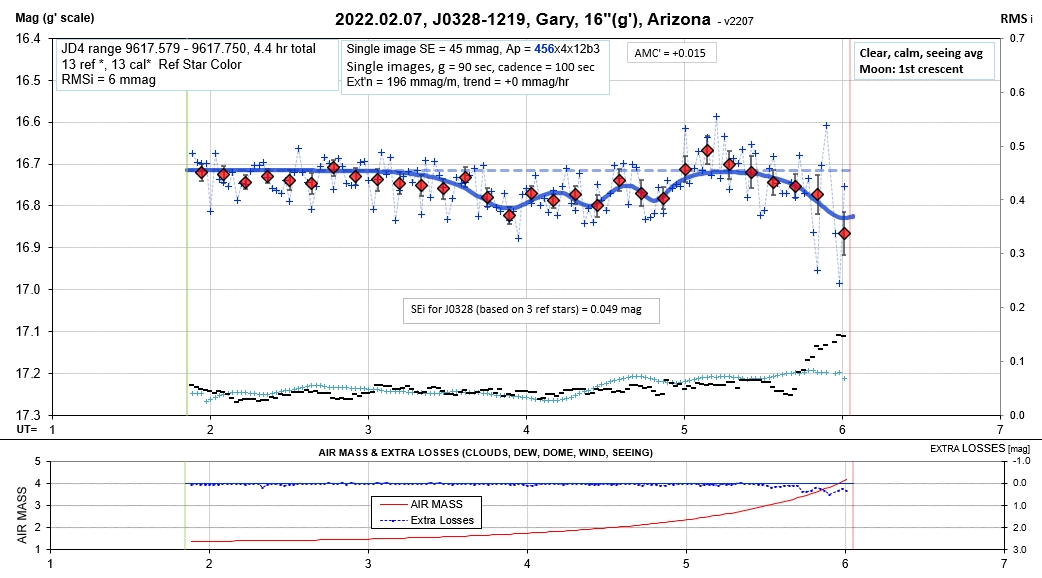
This web page is meant to be an archive of my light curve observations for "observing season #2" of white dwarf J0328 using the HAO backyard observatory 16" Ritchey-Chretien AstroTech telescope with a SBIG XME-10 CCD, g' band filter (link). Most of my web pages are meant for documenting observations and analysis results for myself (it's easier than using a filing cabinet). My web pages can sometimes serve to help with collaborations if I join with others to study the same star. This web page may serve these dual purposes since I'm aware of a group of astronomers (headed by Zachary Vanderbosch) that is engaged in a second observing season of observations following publication about the variable nature of J0328 during a first observing season. My Web Site #1 is located at http://www.brucegary.net/J0328/; it includes my observations during the first observing season (2020.12.02 to 2021.02.12).
To view the Season#3 web page for this star system, go to http://www.brucegary.net/J0328-3/ (2022.08.29 to now)
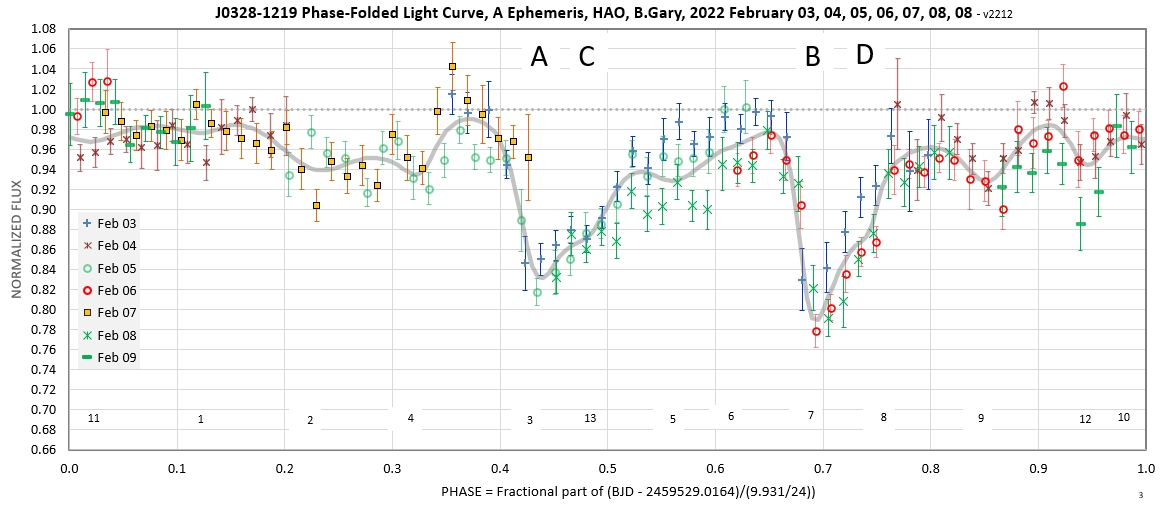
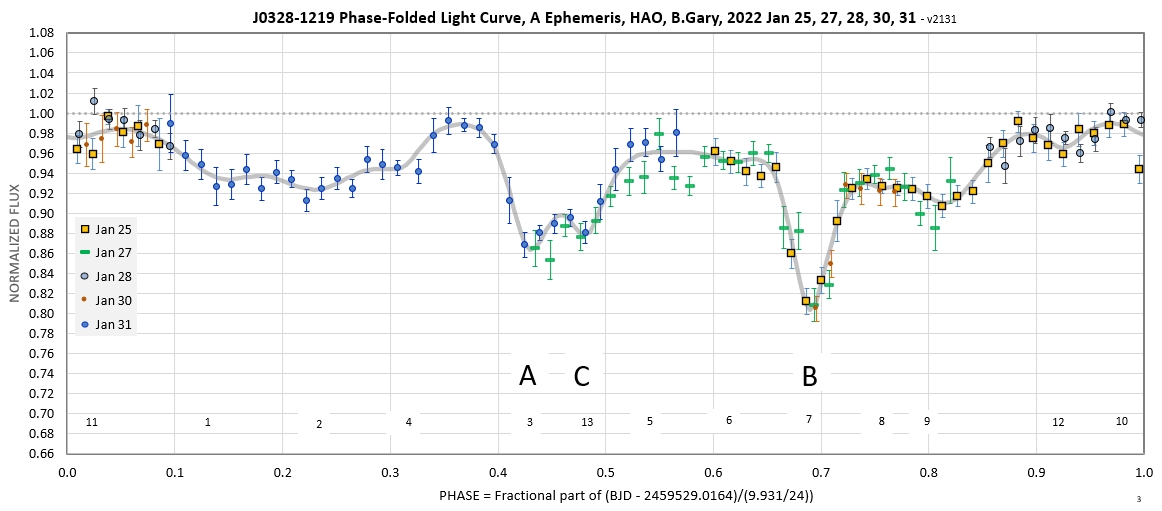
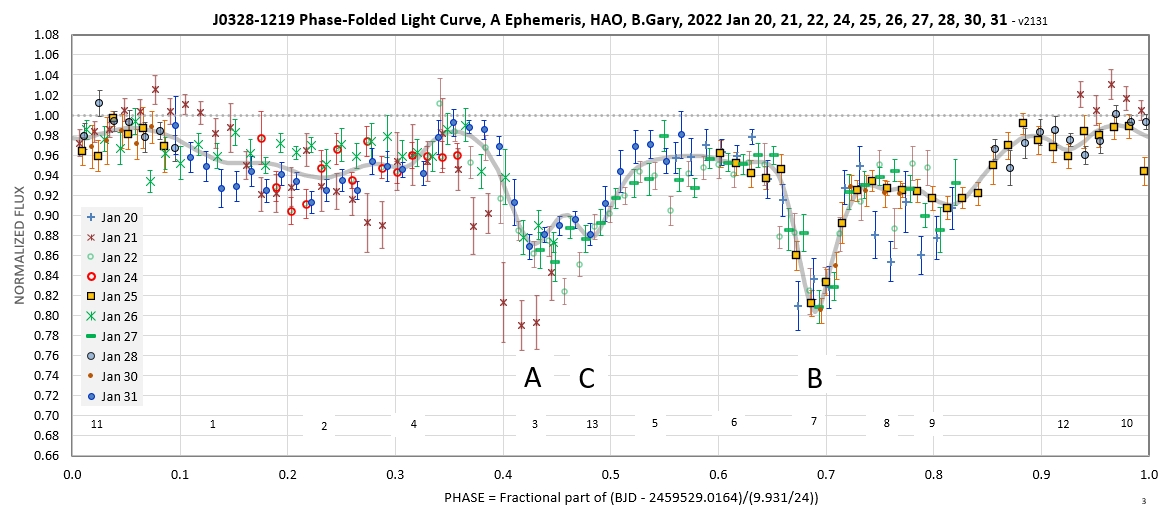
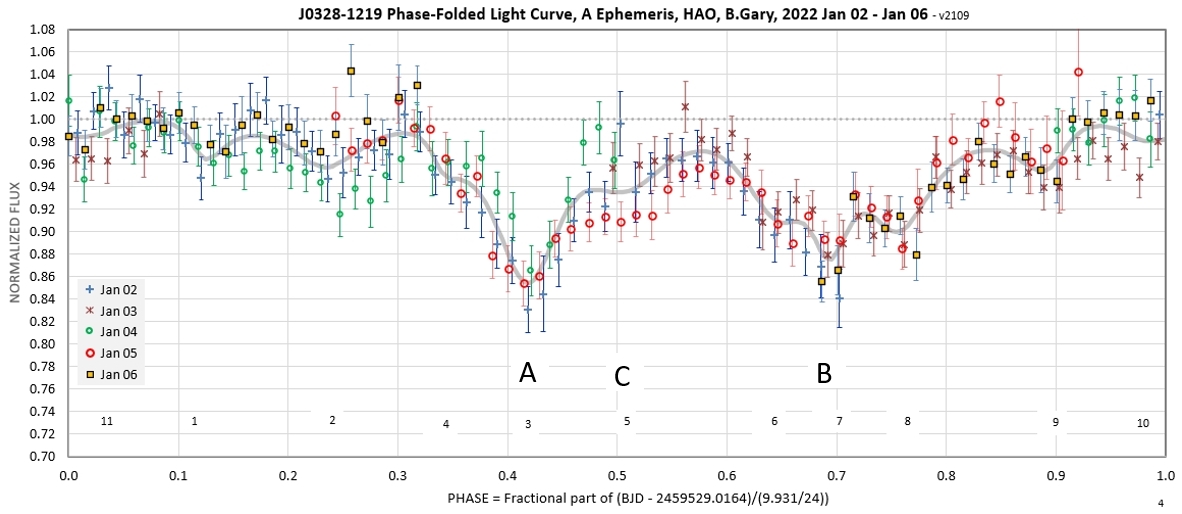
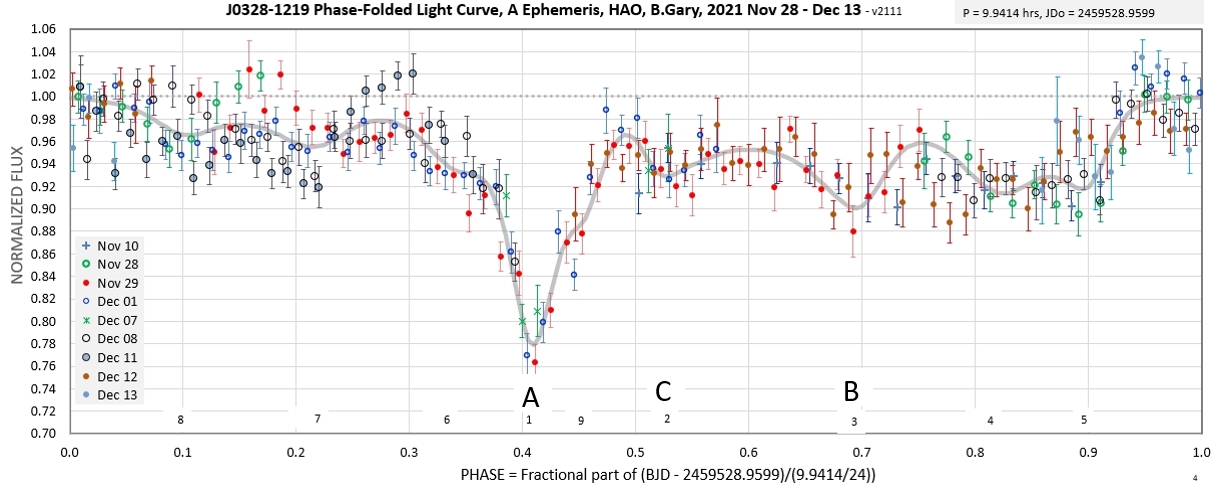
General
Information
RA/DE = 03:28:33.7
-12:19:45, g'-mag = 16.7, white dwarf type DZ, T_eff = 8750
(170) K (Guidry et al., 2020). Observing season is centered on
Nov 18 (and extends from about Aug 01 to Mar 05).
Observing session dates
Observing session LCs
Periodogram analyses
Trends
Finder
image
Physical model suggestion
References
Related external links
2022.02.09
Data Exchange: Feb03 to Feb09 link
2022.02.08
2022.02.07
2022.02.06
2022.02.05
2022.02.04
2022.02.03
2022.01.31
Data Exchange Jan20 to Jan31 link
2022.01.30
2022.01.28
2022.01.27
2022.01.26
2022.01.25
2022.01.24
2022.01.22
2022.01.21
2022.01.20
2022.01.06
Data Exchange Jan02 to Jan06 link (changed
format)
2022.01.05
2022.01.04
2022.01.03
2022.01.02
2021.12.13
Data Exchange Nov10 to Dec13 link
2021.12.12
2021.12.11
2021.12.08
2021.12.07
2021.12.01
2021.11.29
2021.11.28
2021.11.14
2021.11.10
Observing Session Light Curves
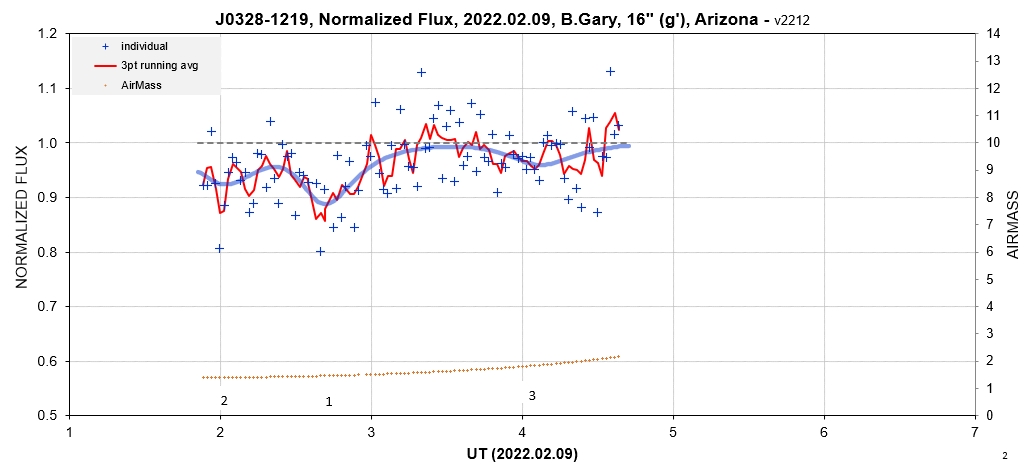
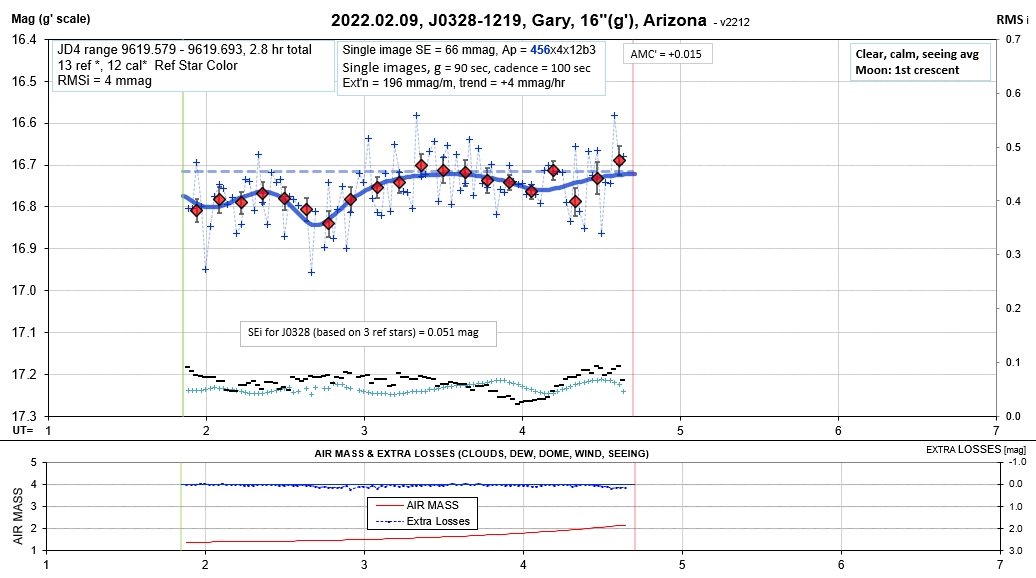
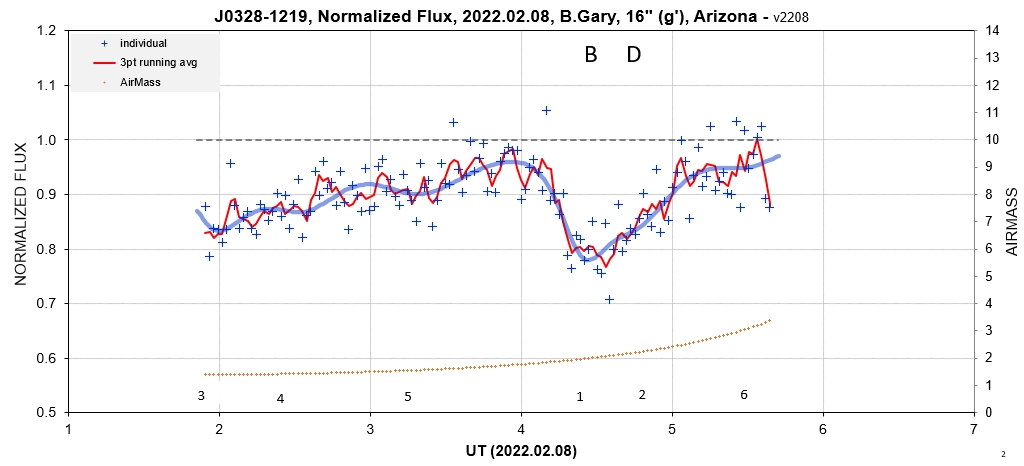
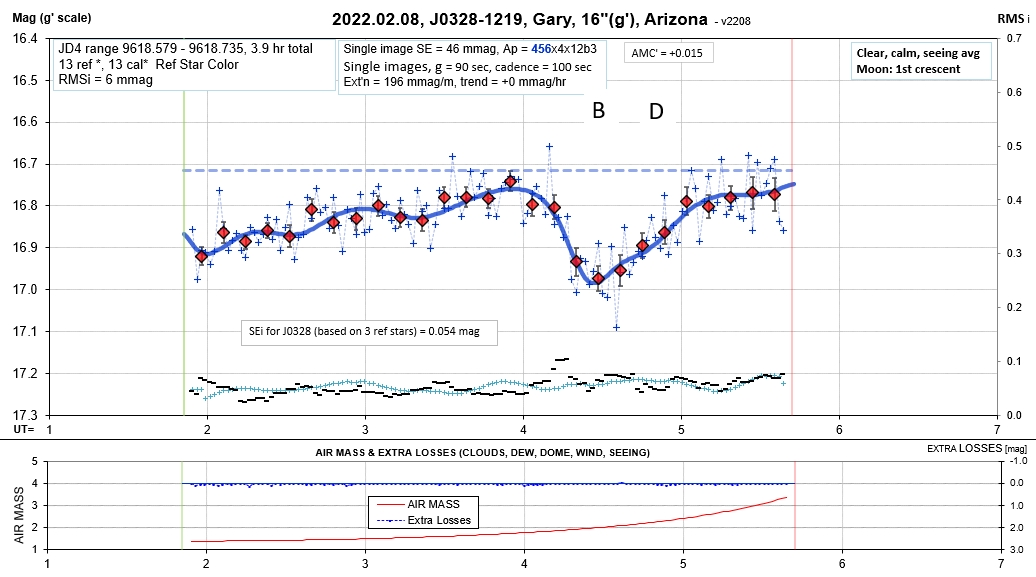
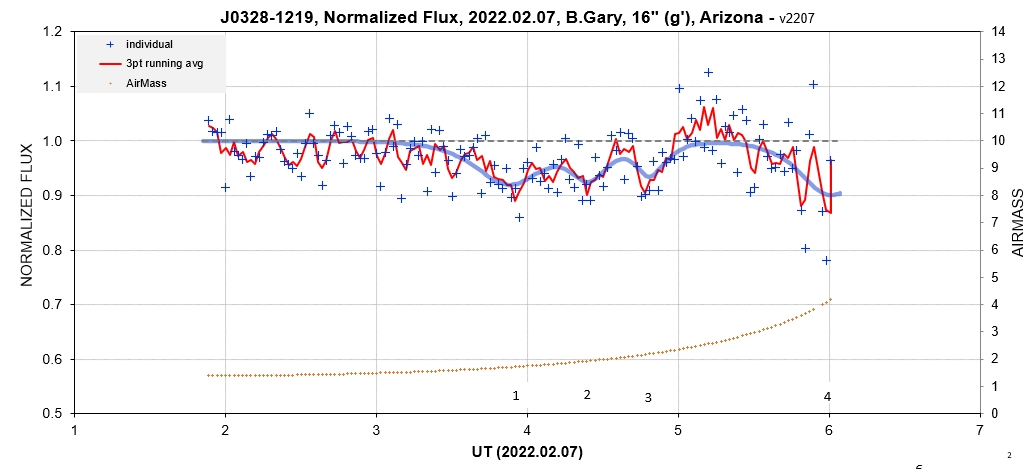

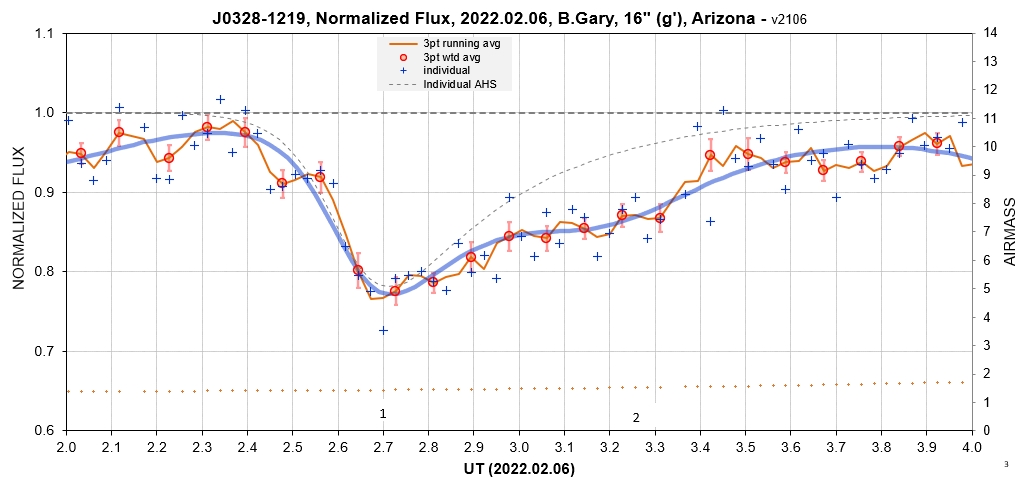
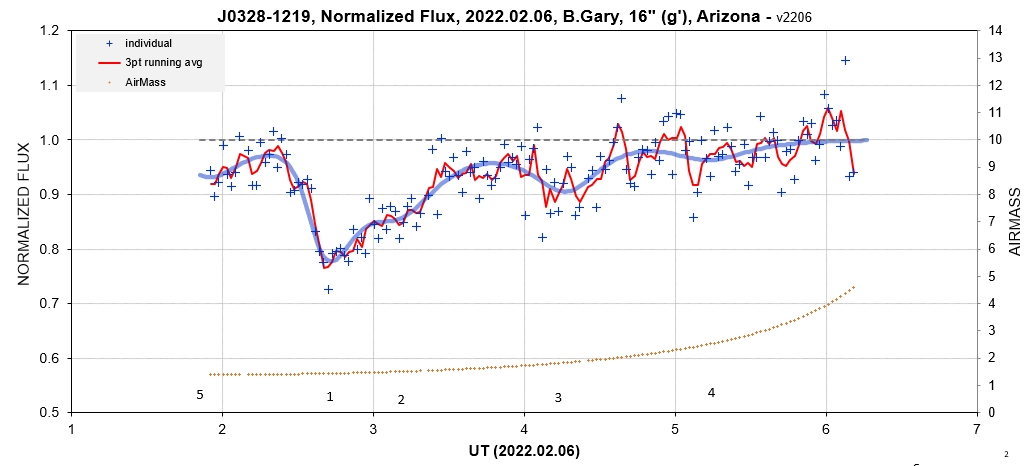
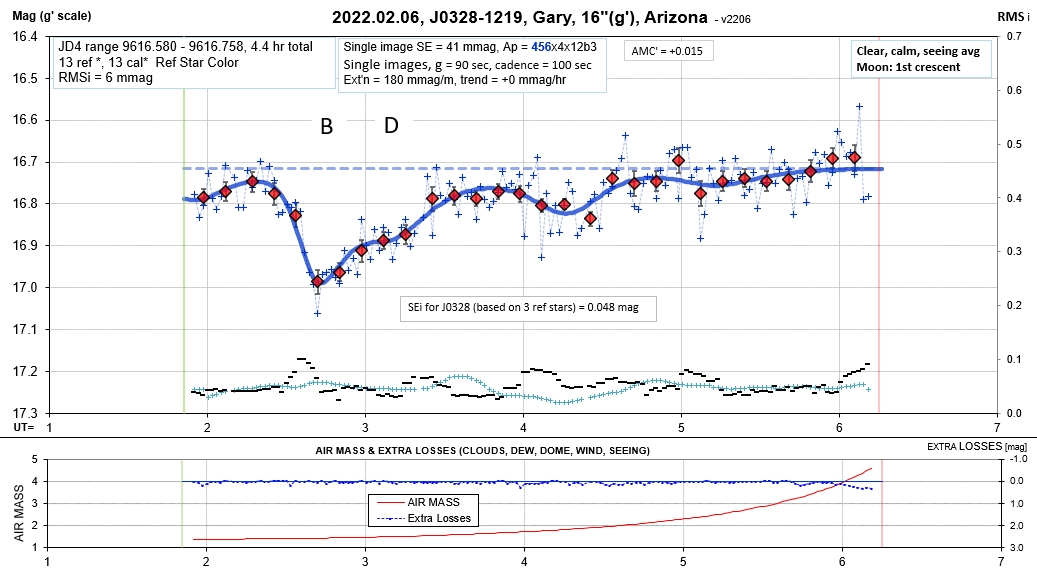
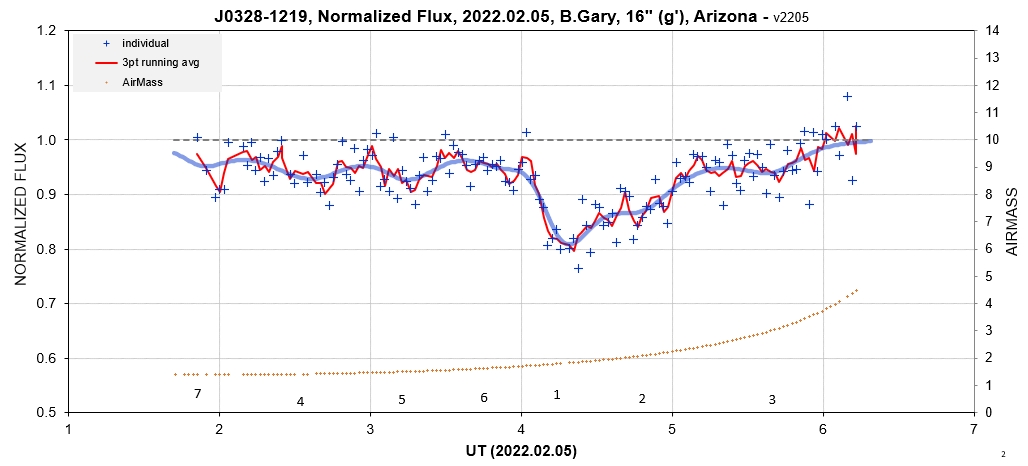
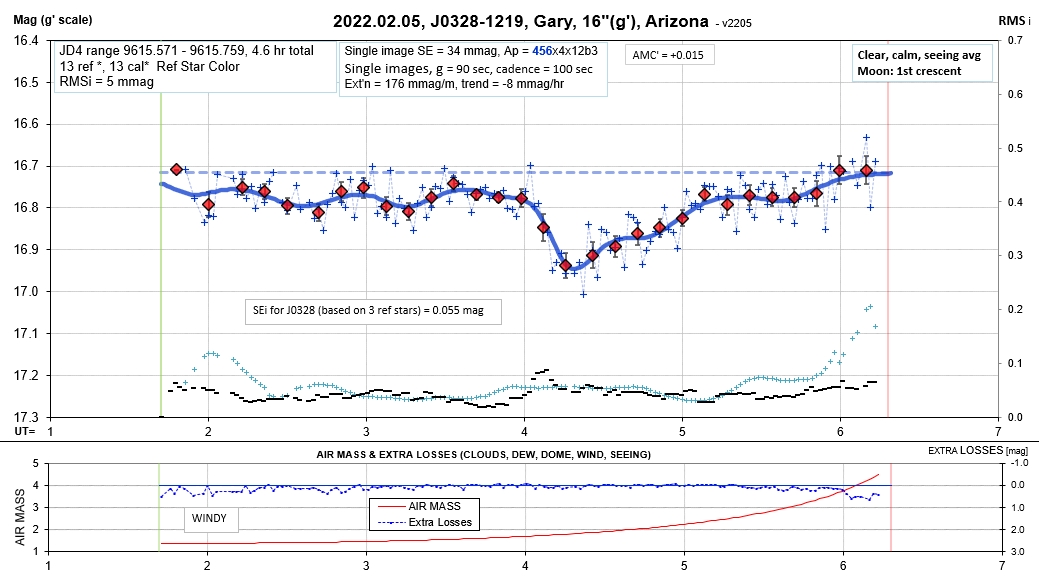
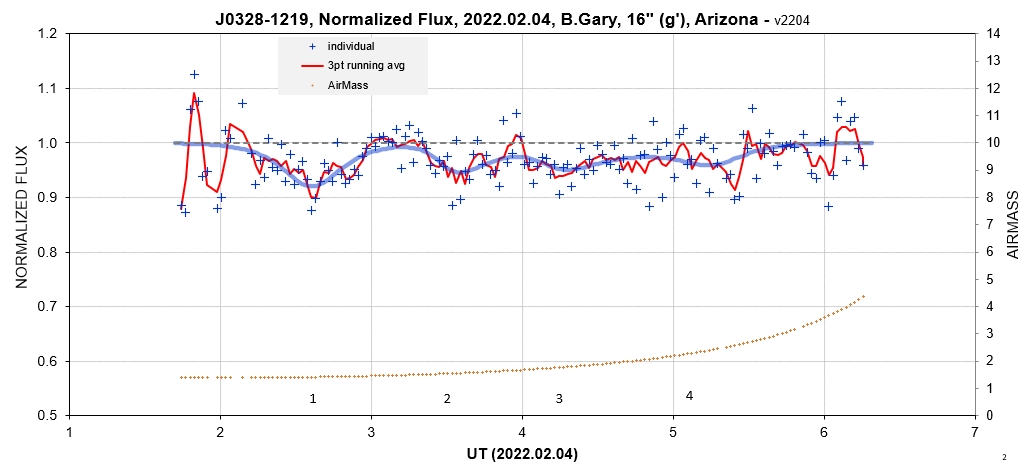
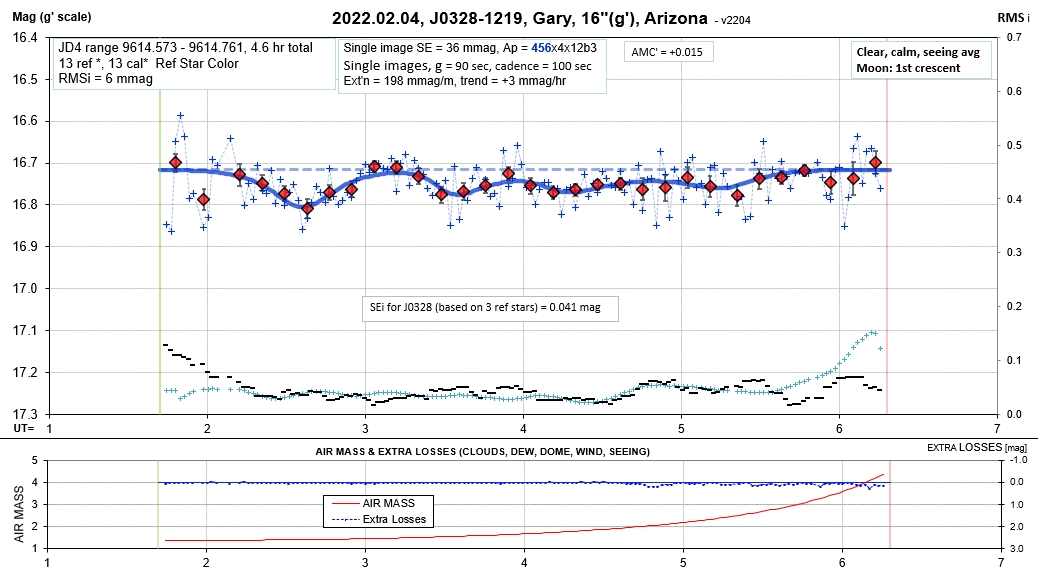
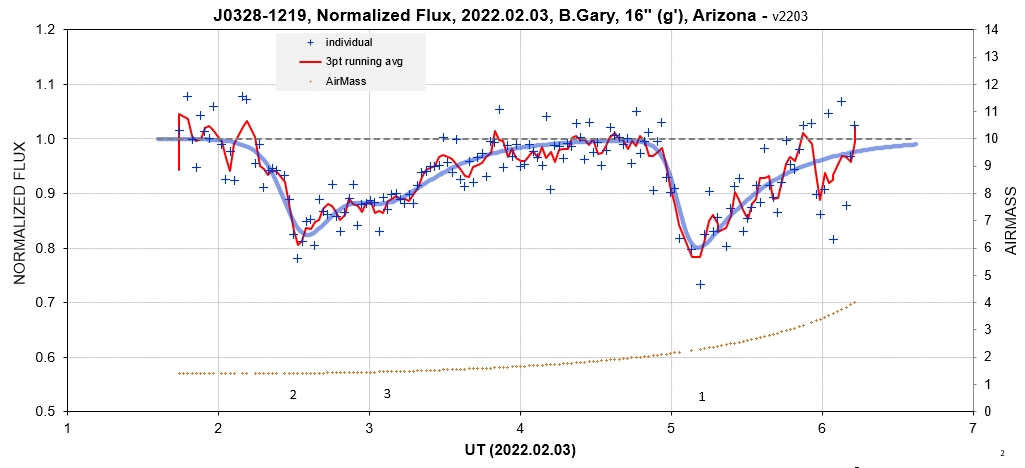
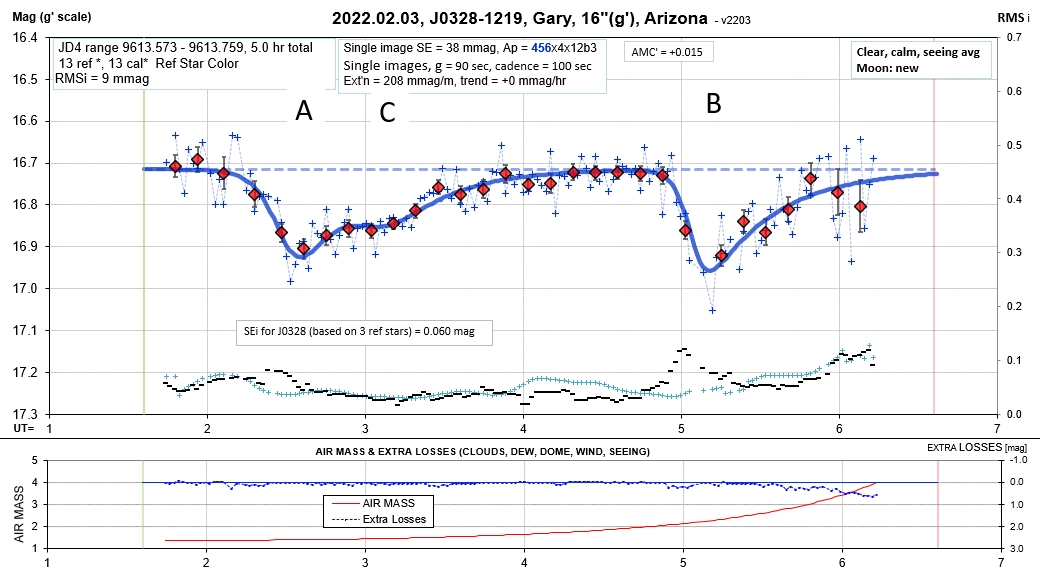
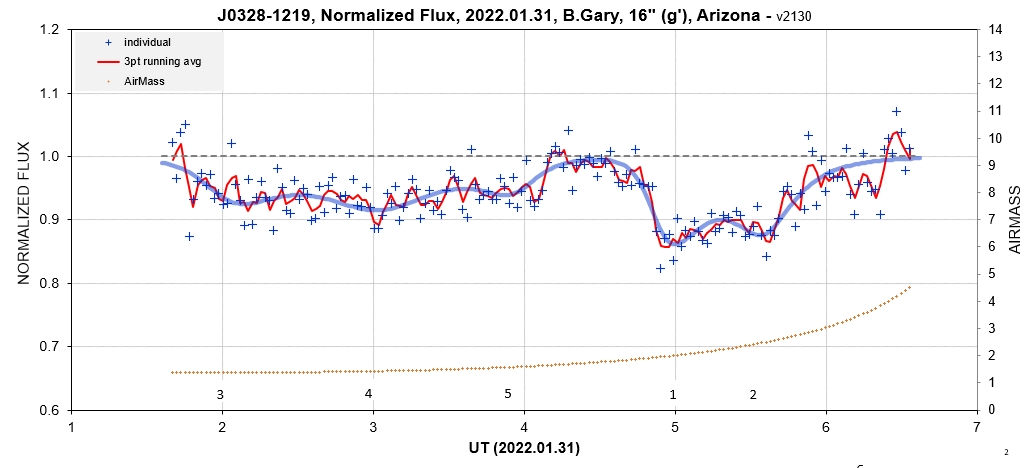
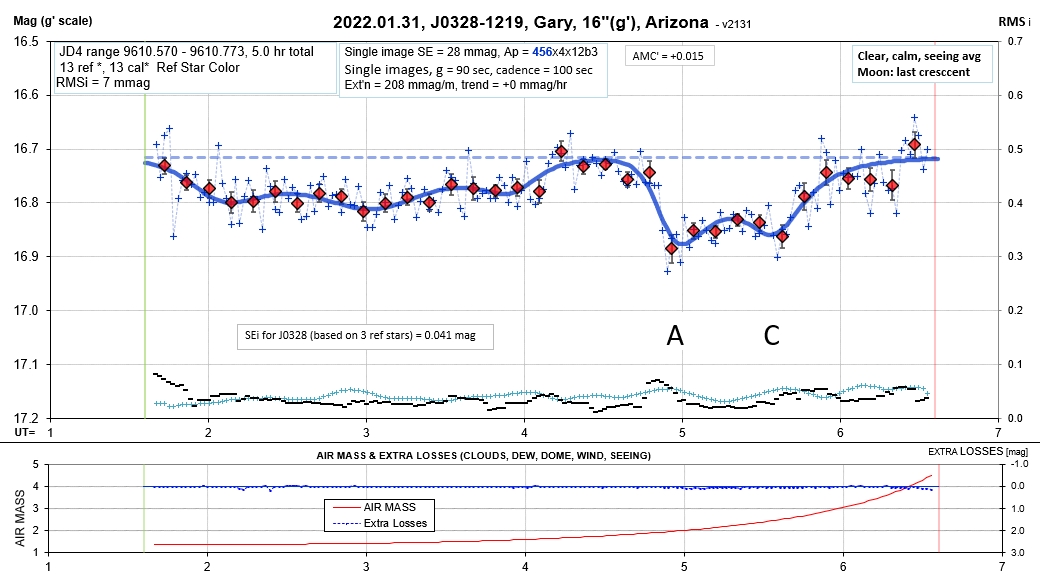
About half of this observing session's data was rejected (due to
clouds).
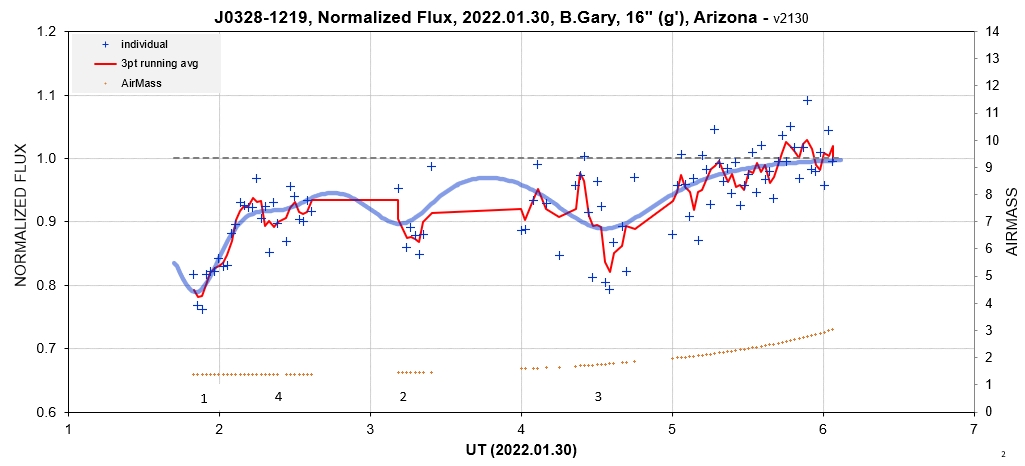
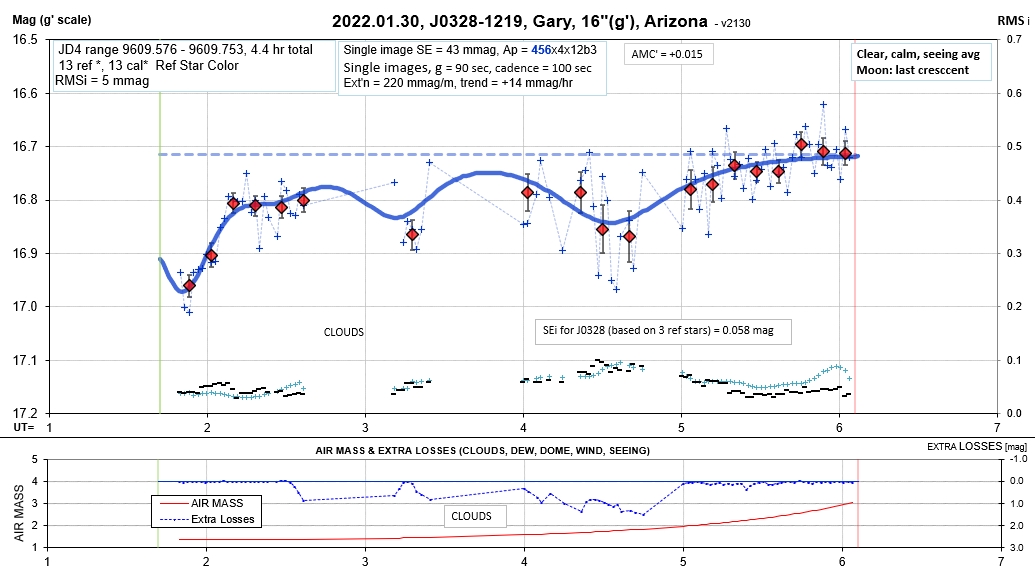
Power down at 4.3 UT.
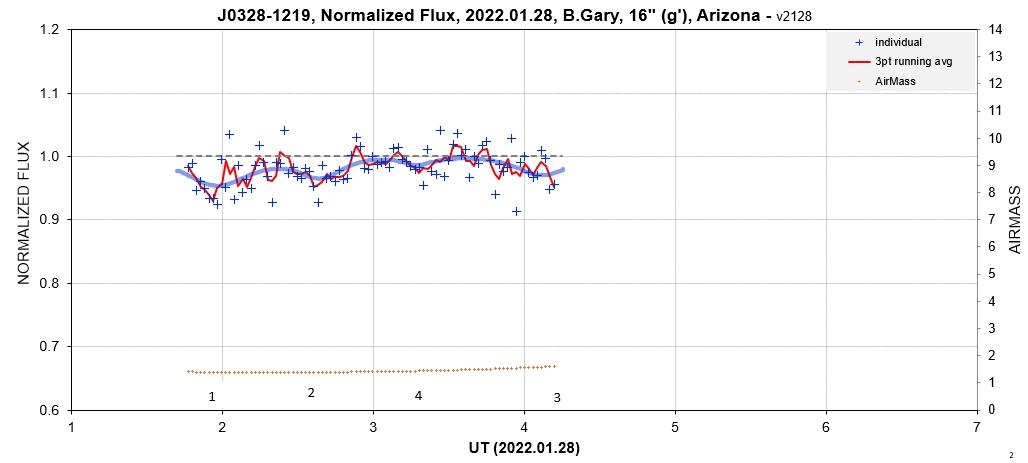
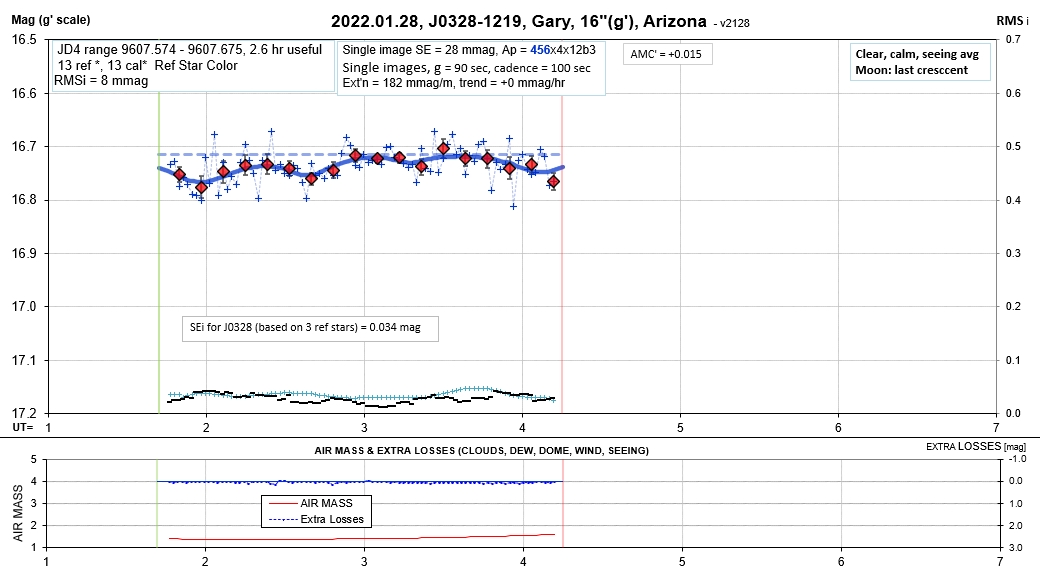
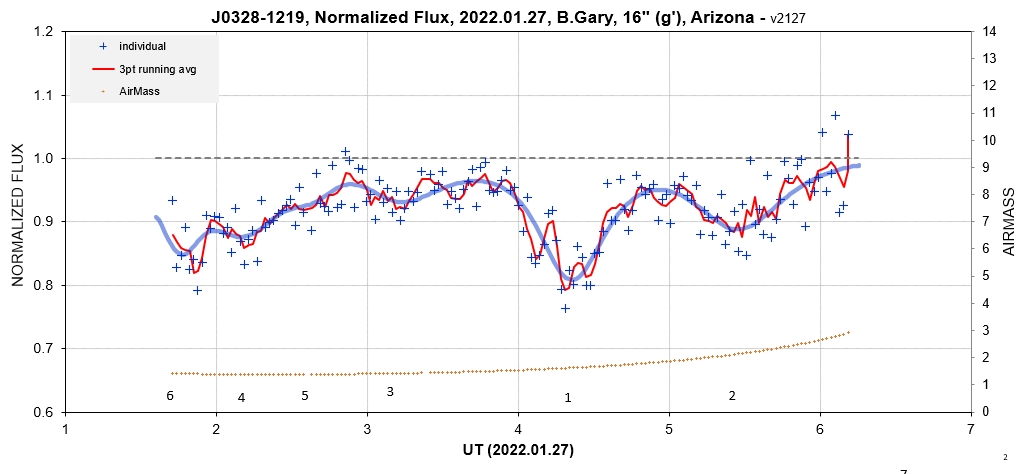
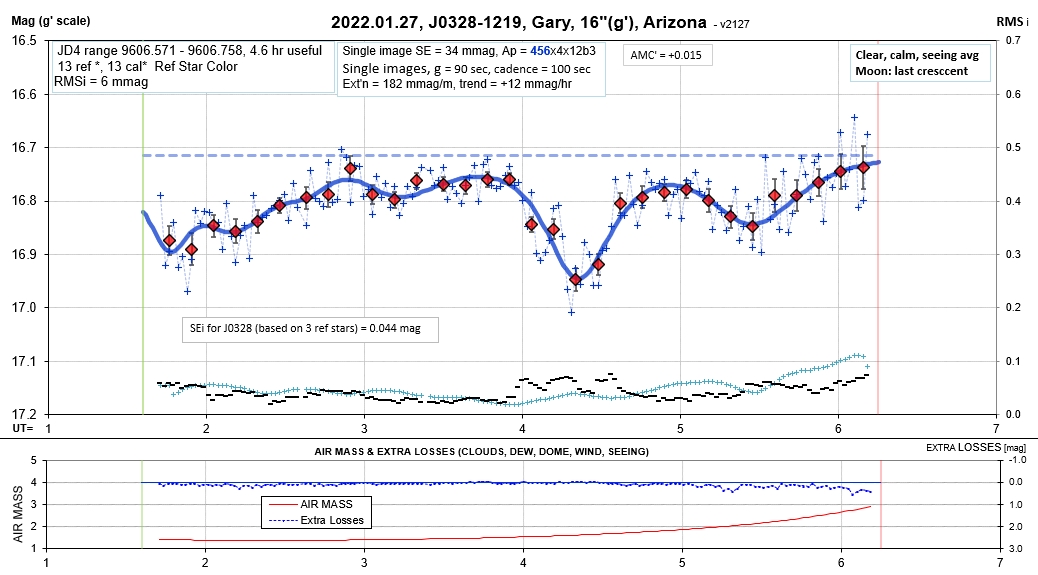
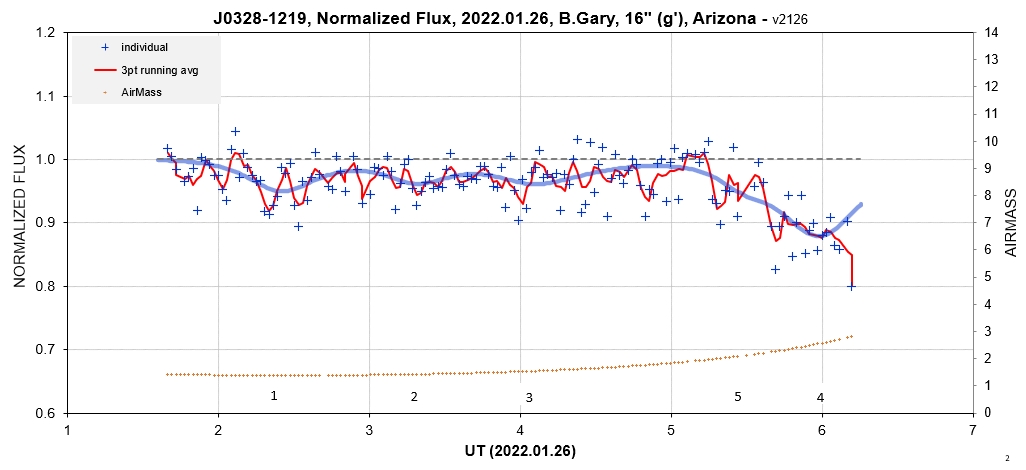
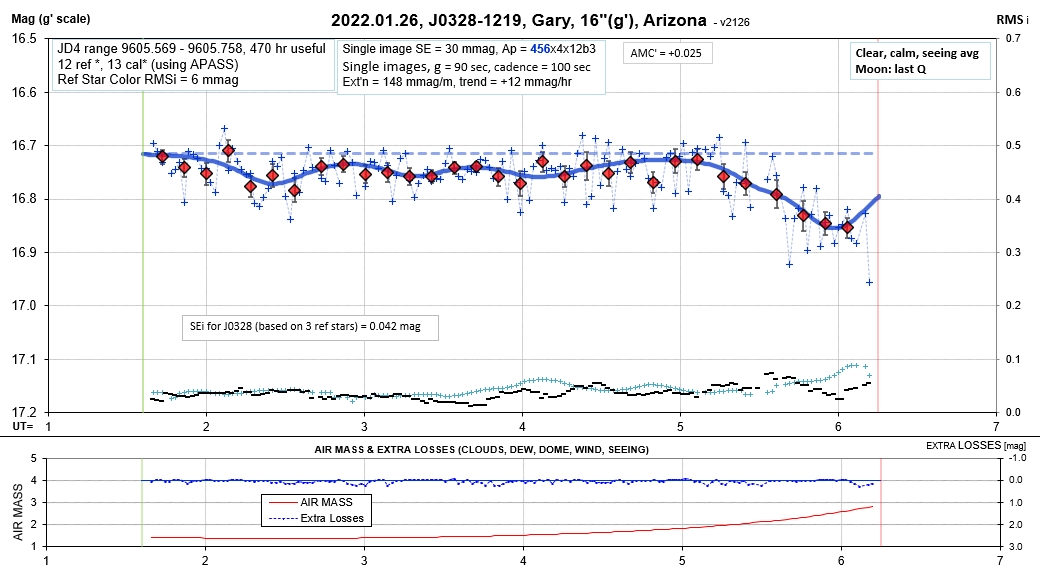
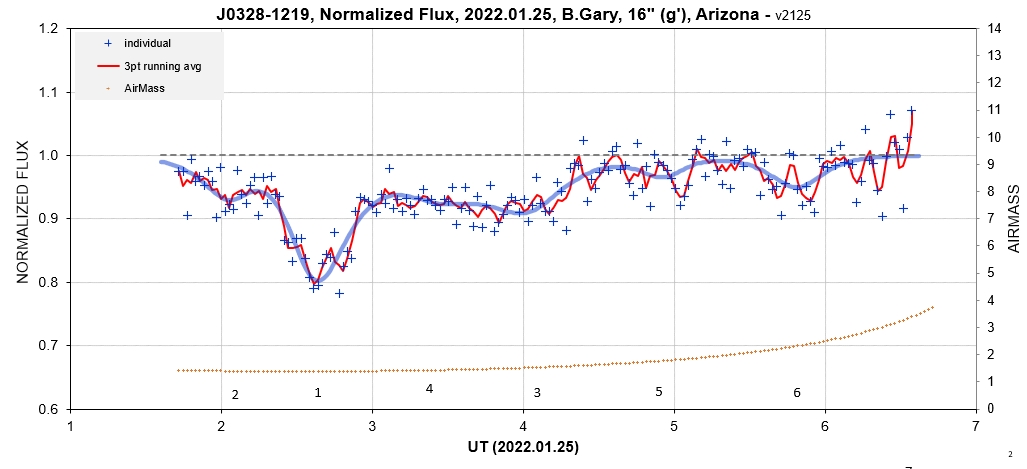
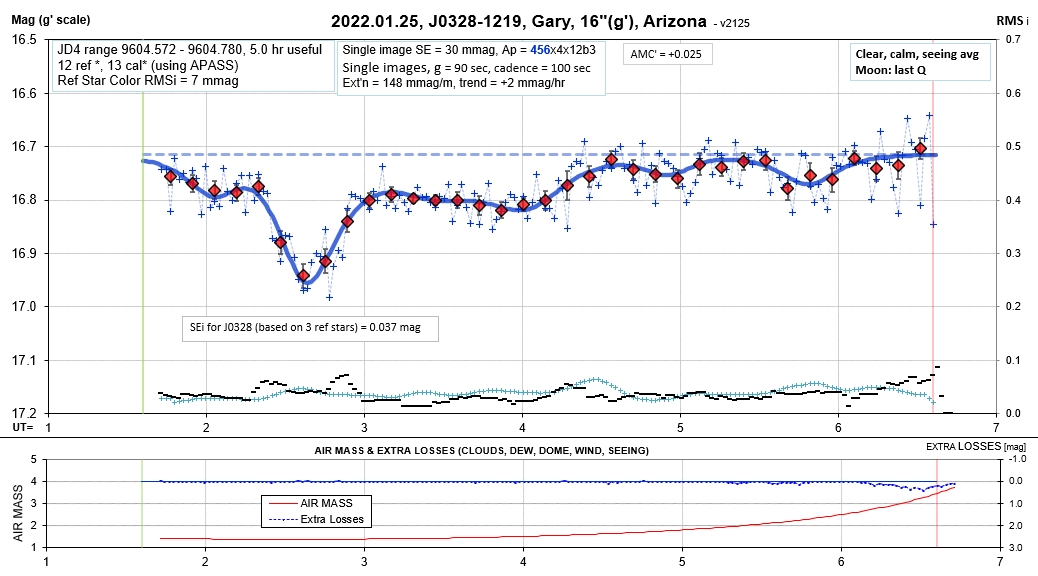
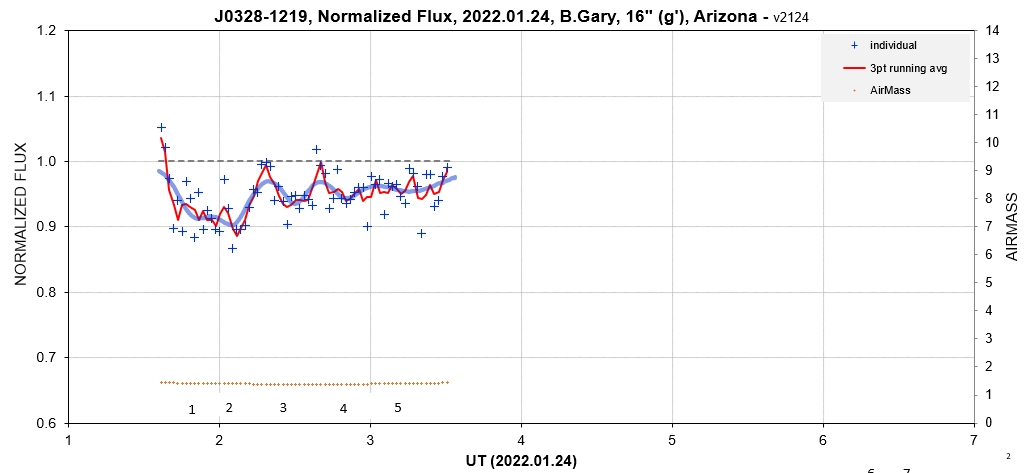
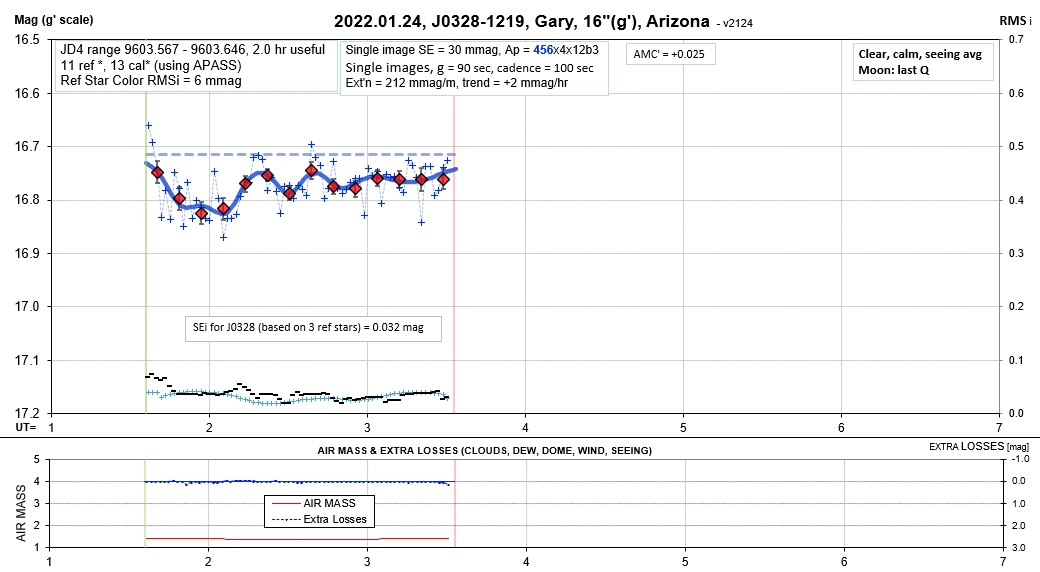
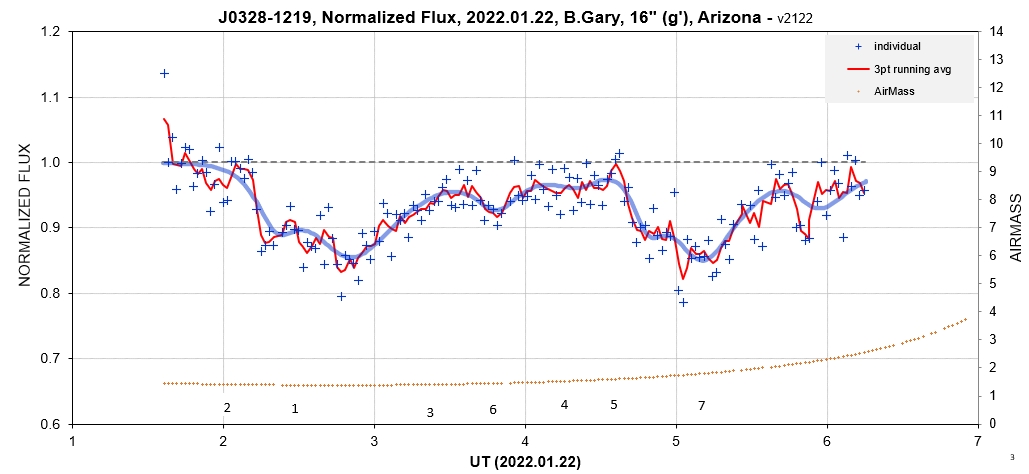
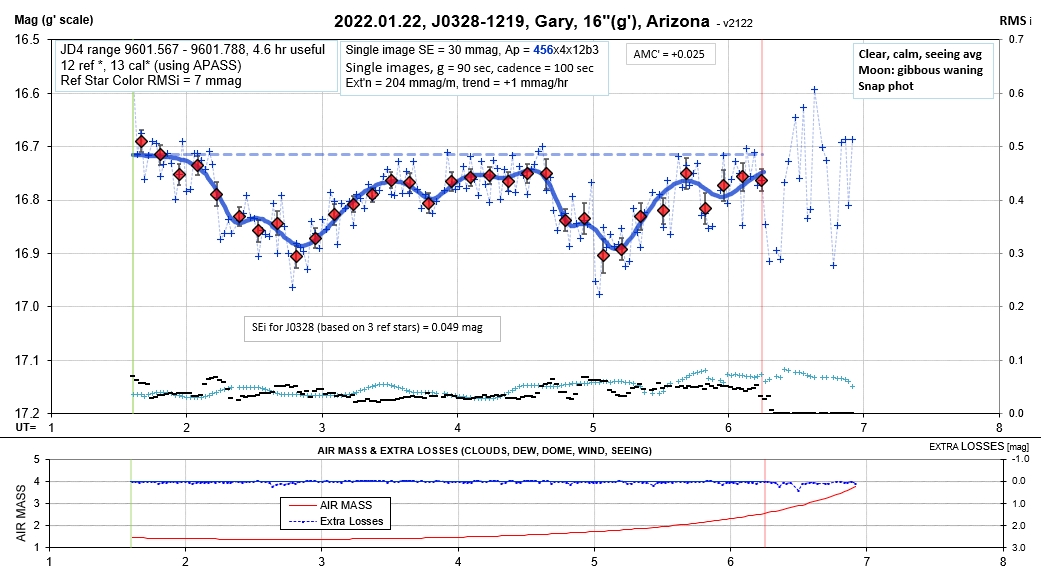
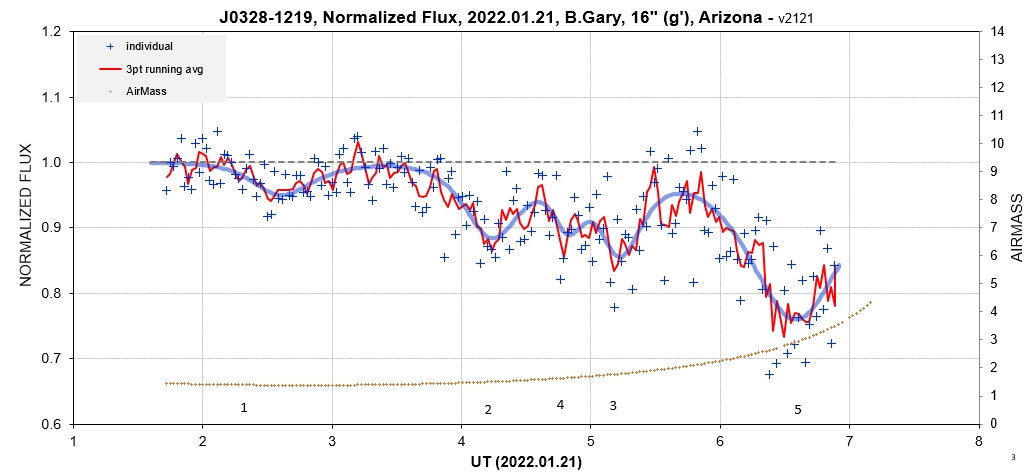
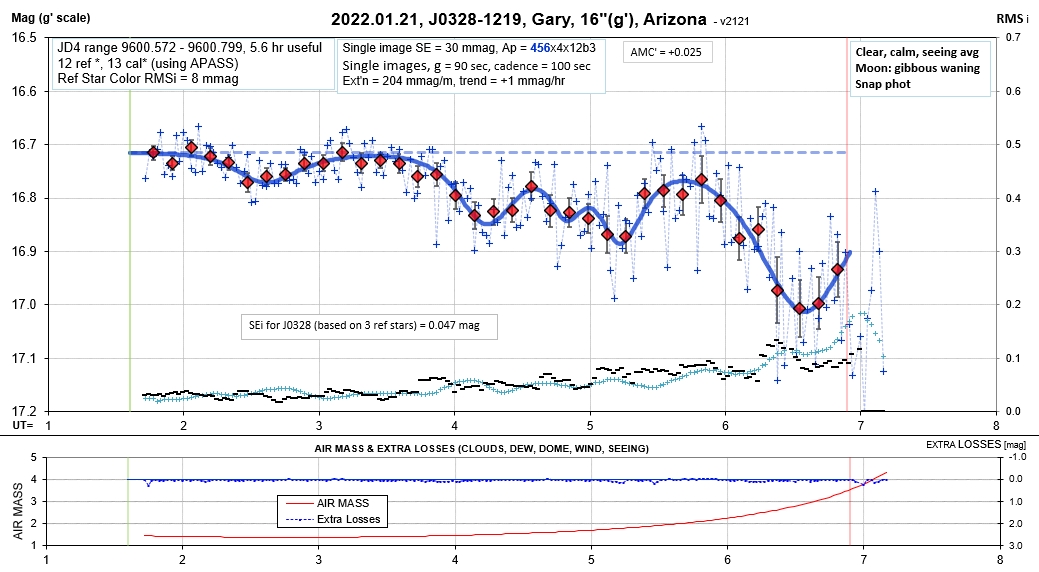
This is the first observing session of "observing session
Group#3."
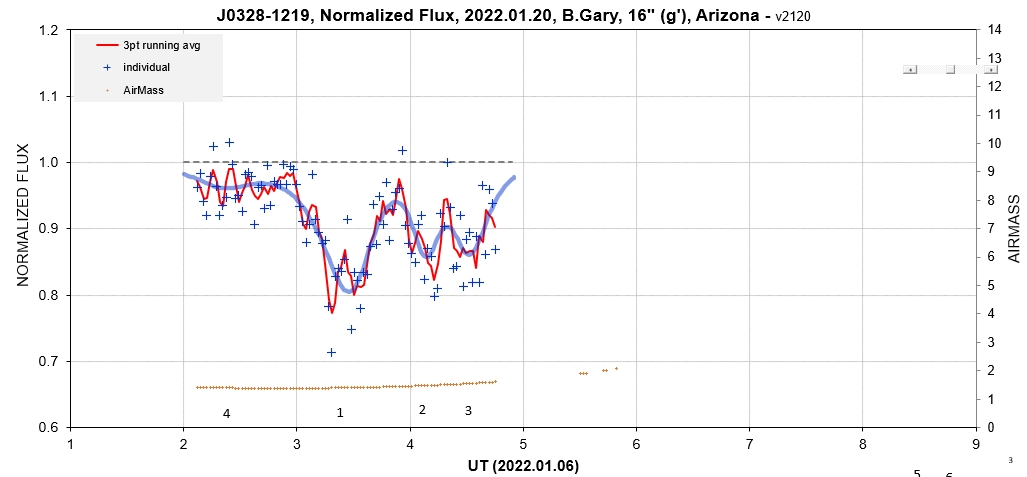
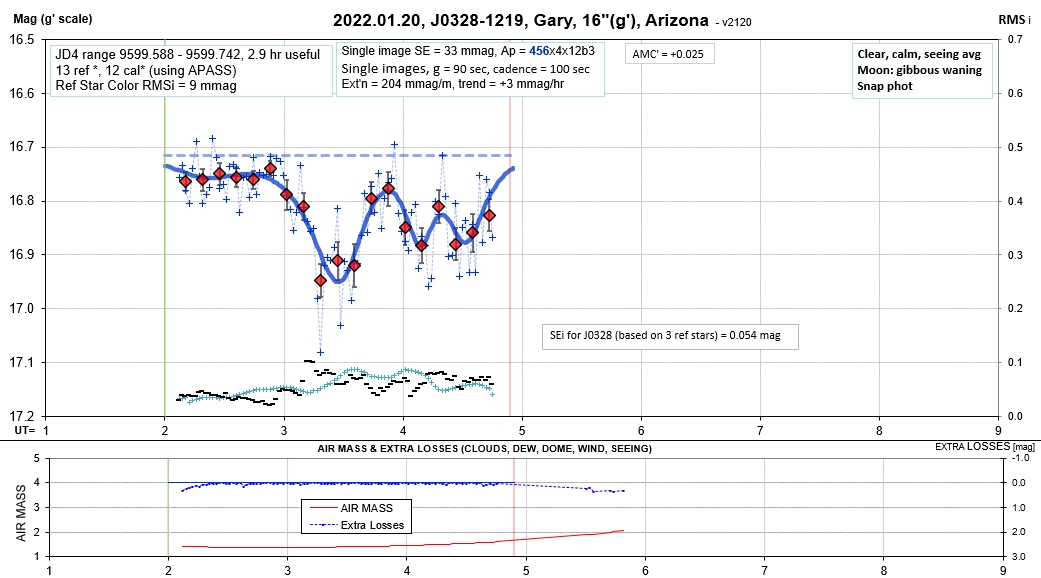
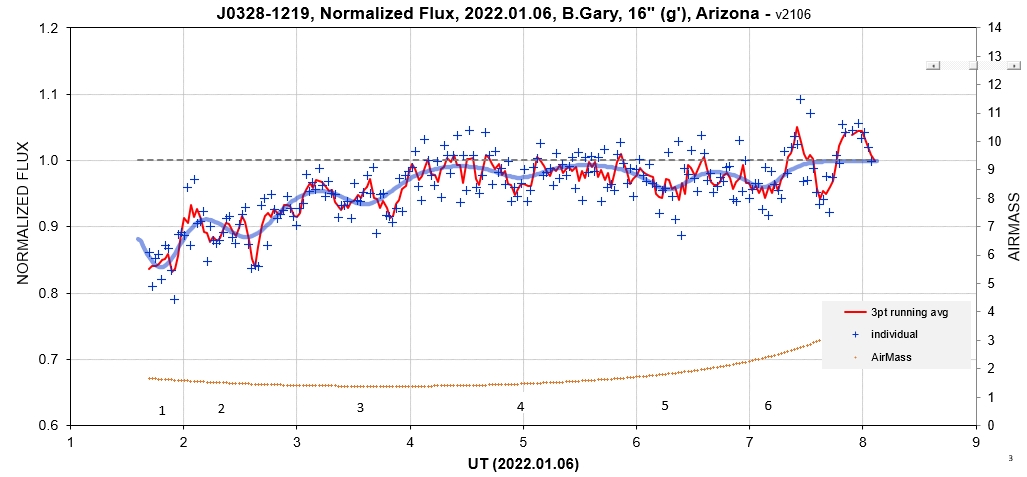
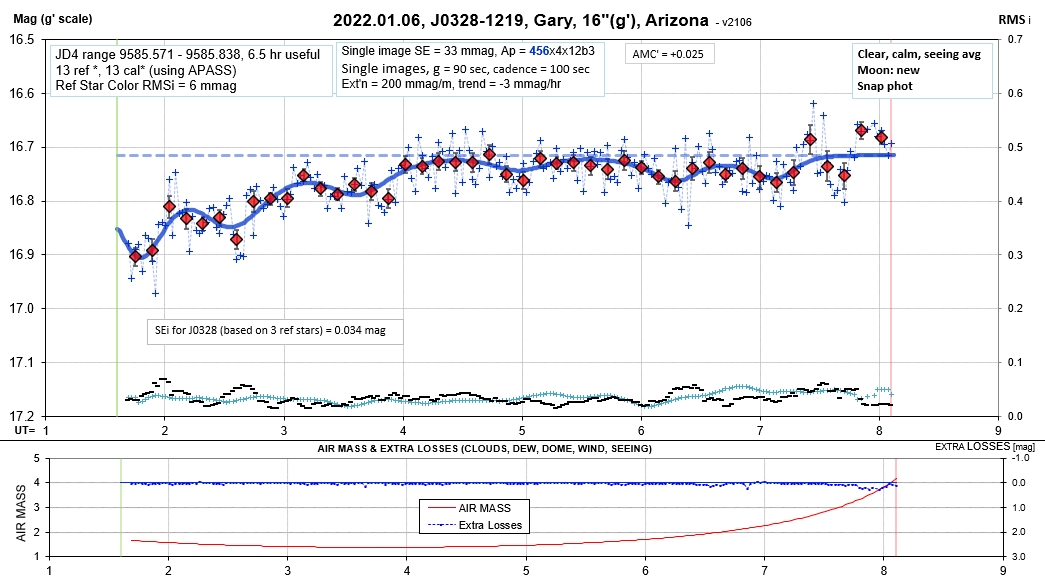
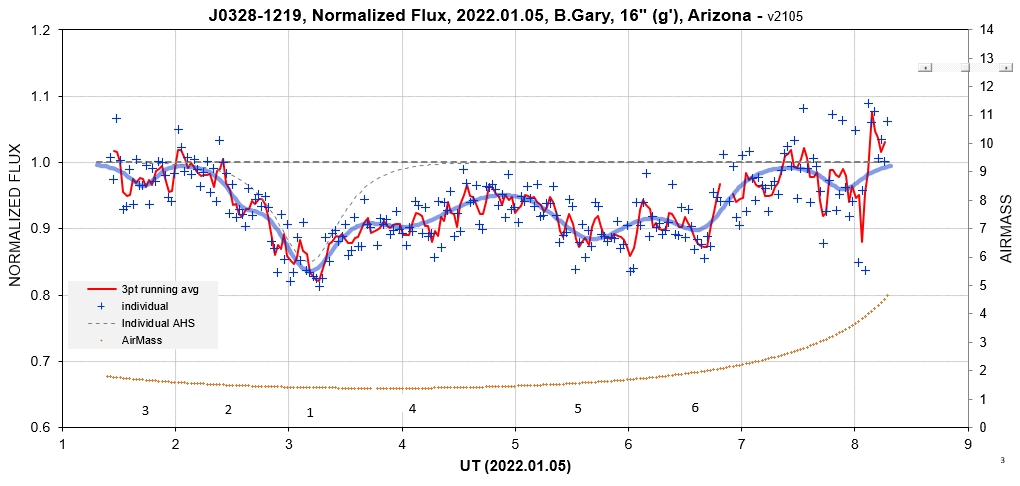
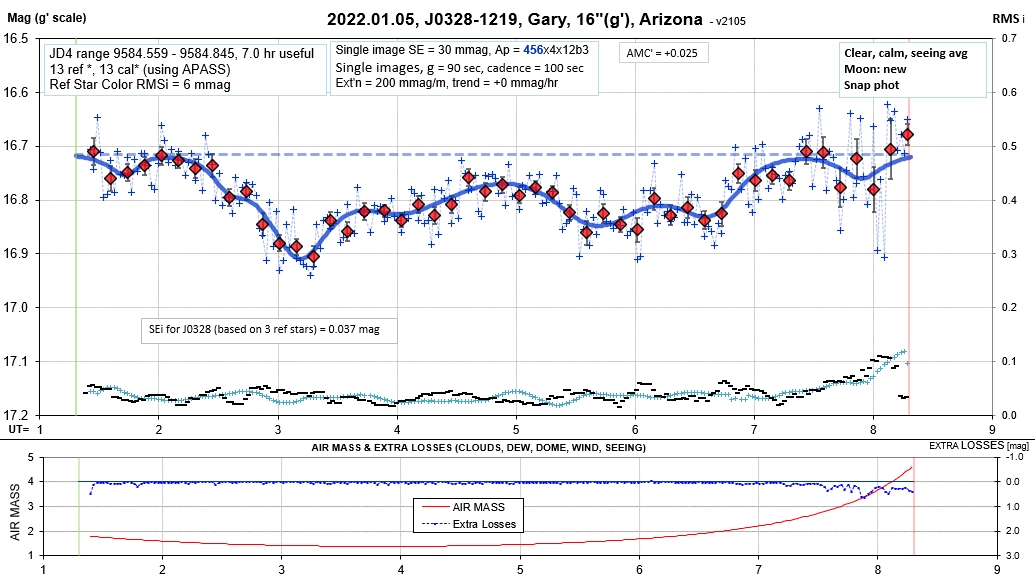
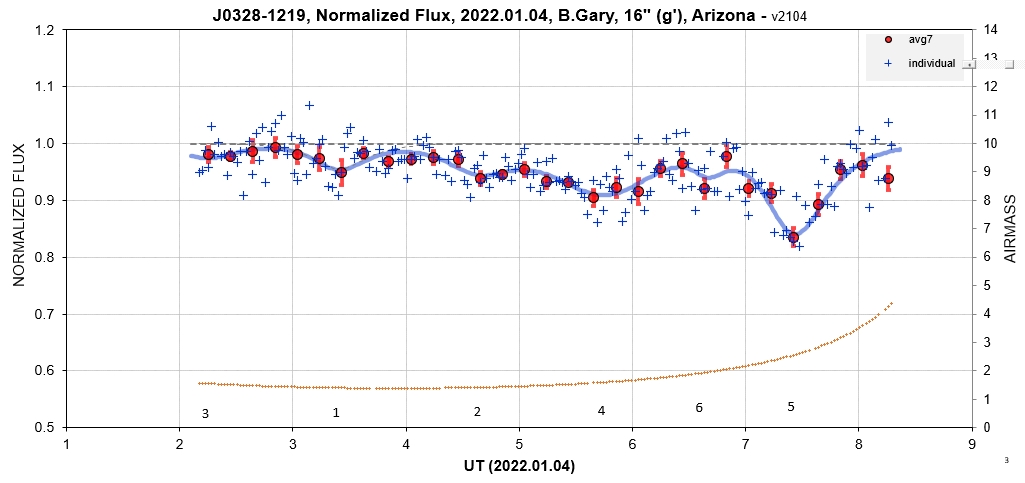
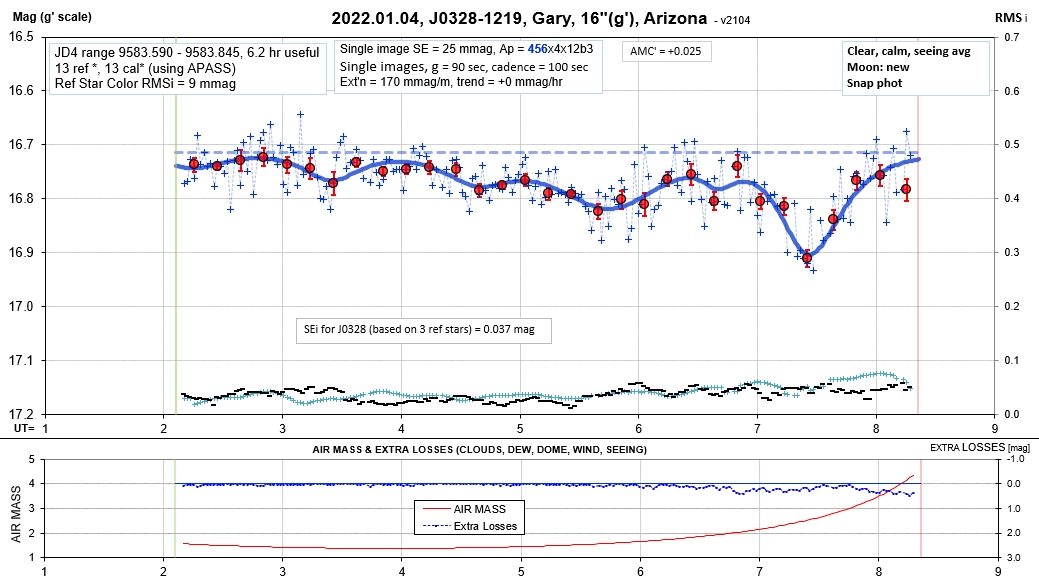
2022.01.03 data
Notice that during the entire 6 hours of this date's observations
there are dust clouds in our line-of-sight; no OOT level data.
This agrees with the expectation using other data in a
phase-folded LC.
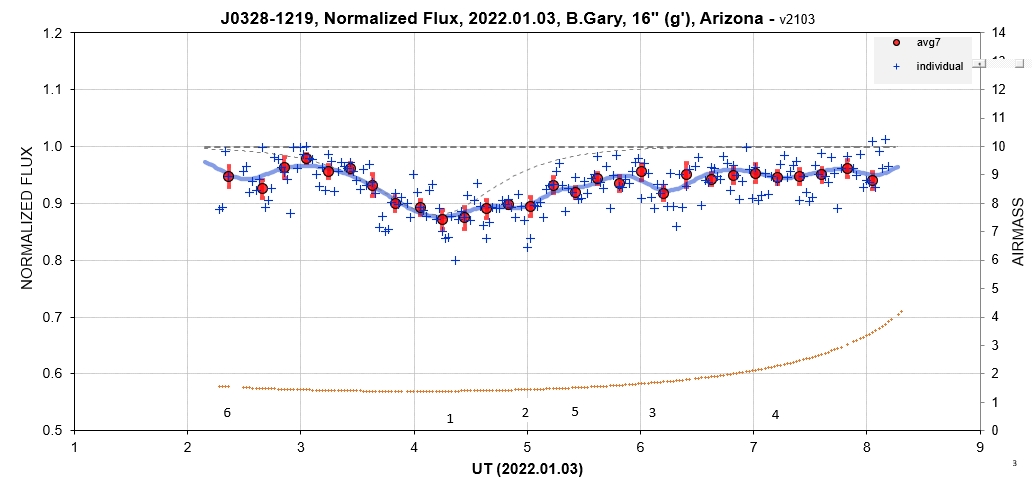
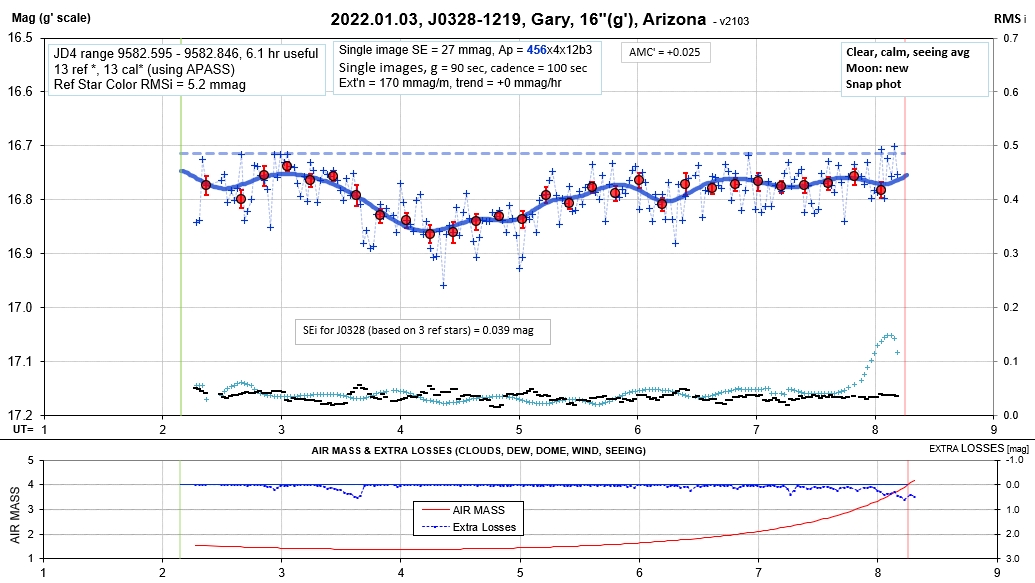
2022.01.02 data
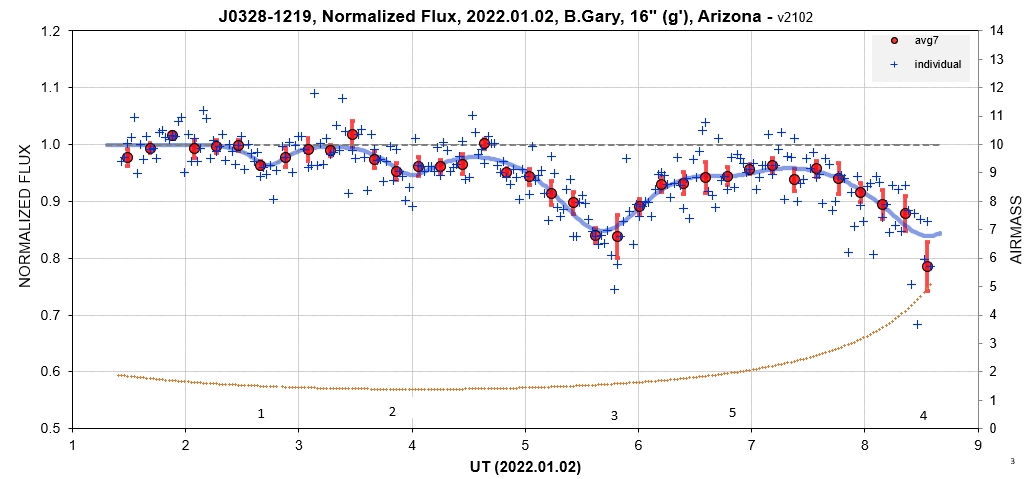
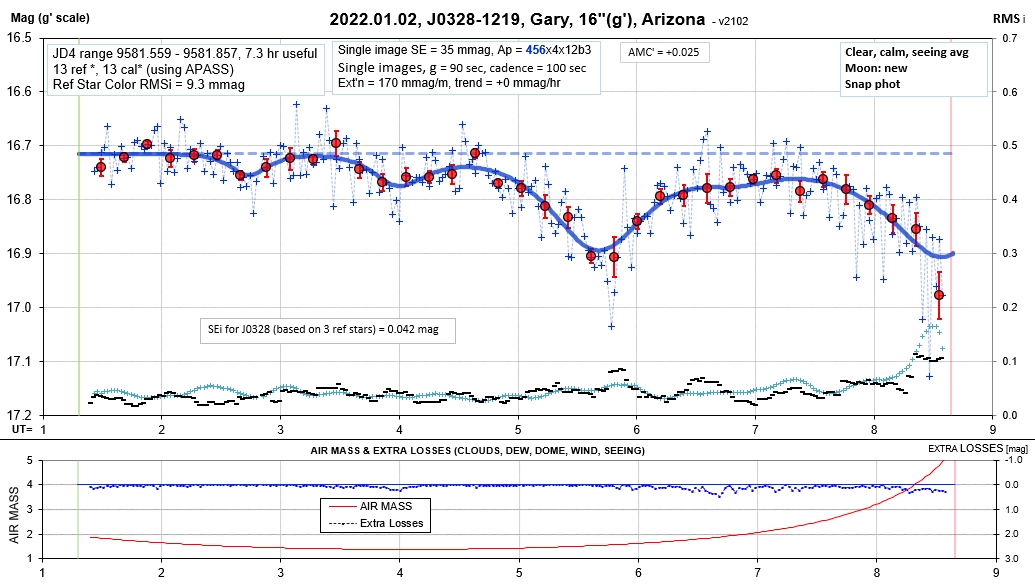
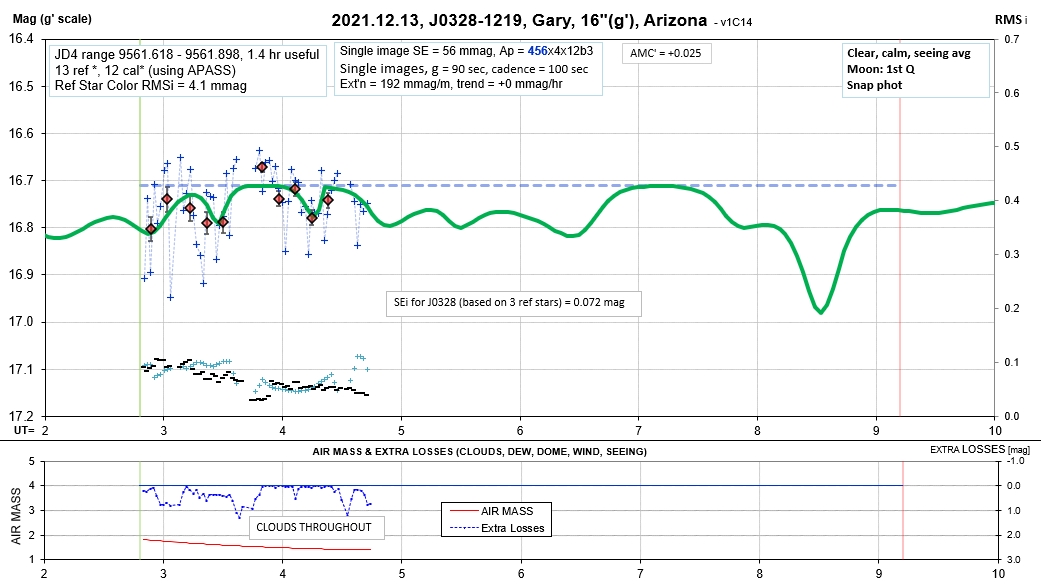
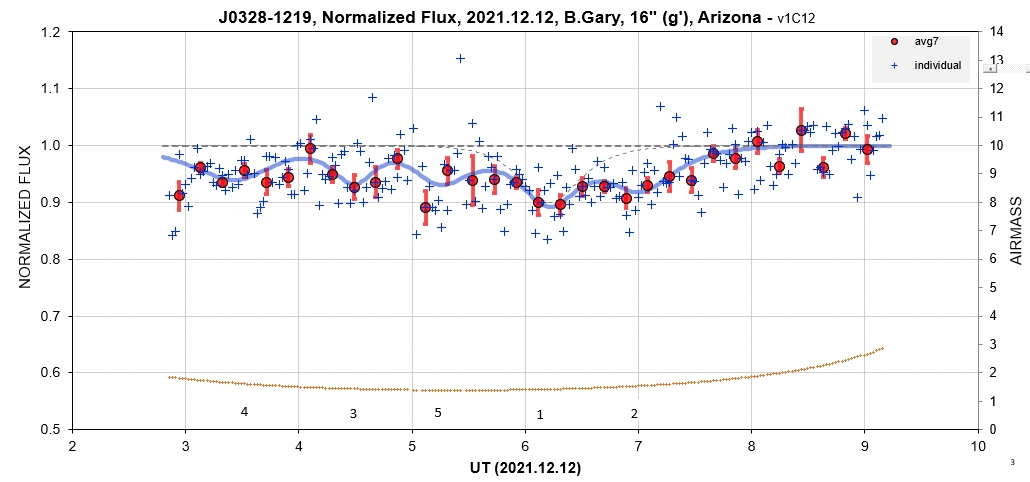
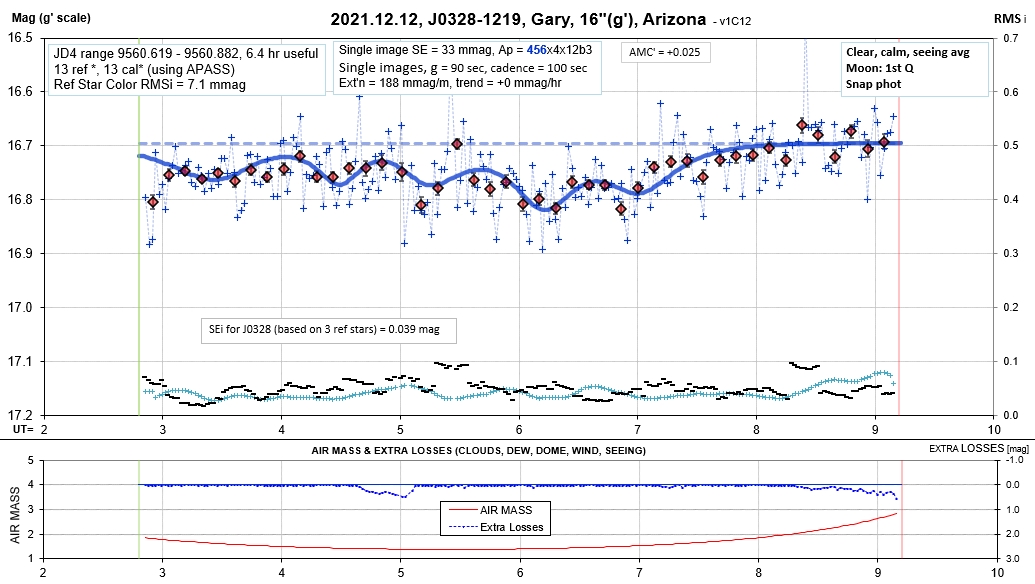
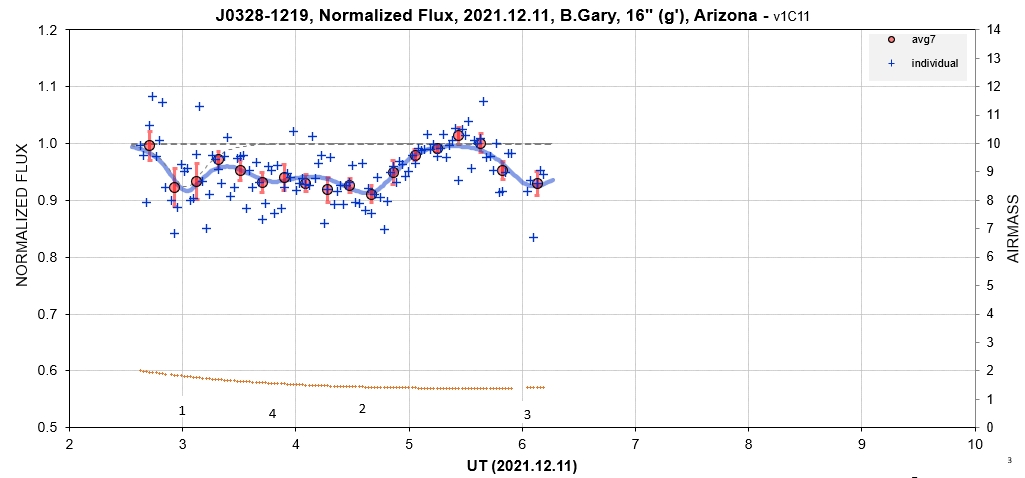
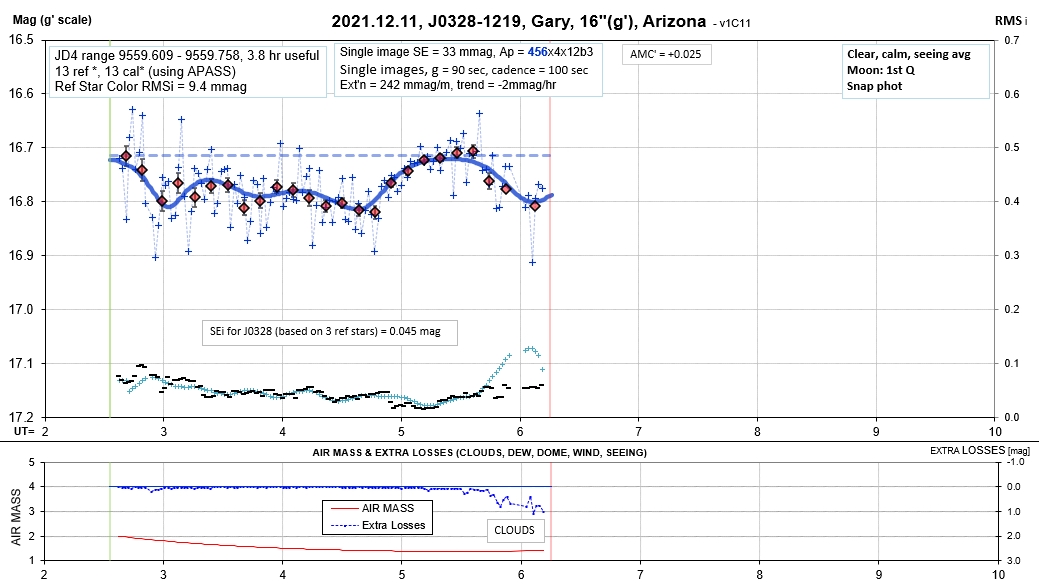
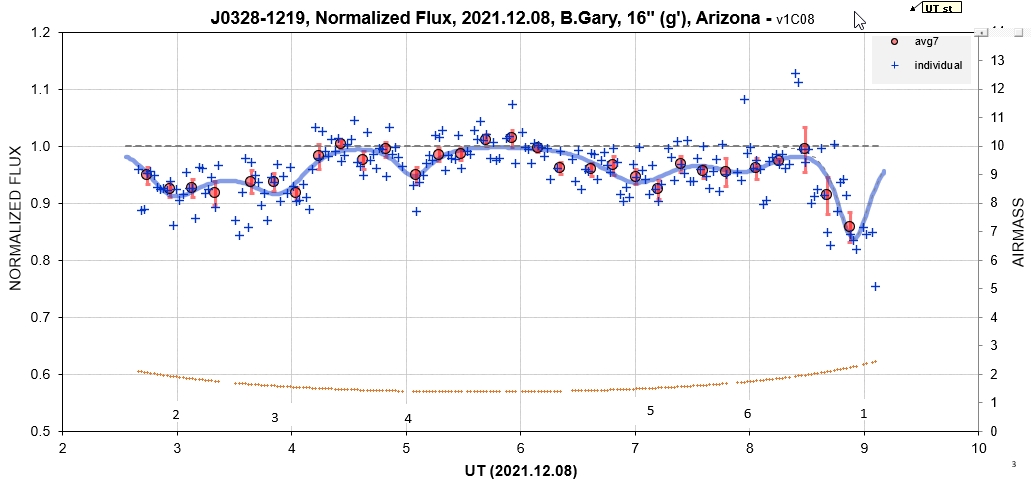
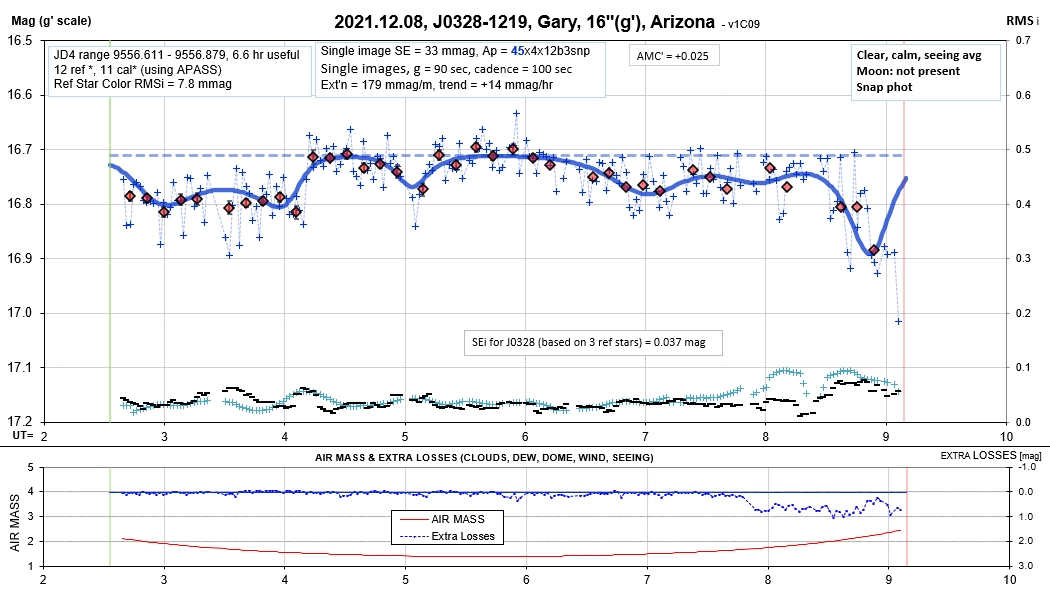
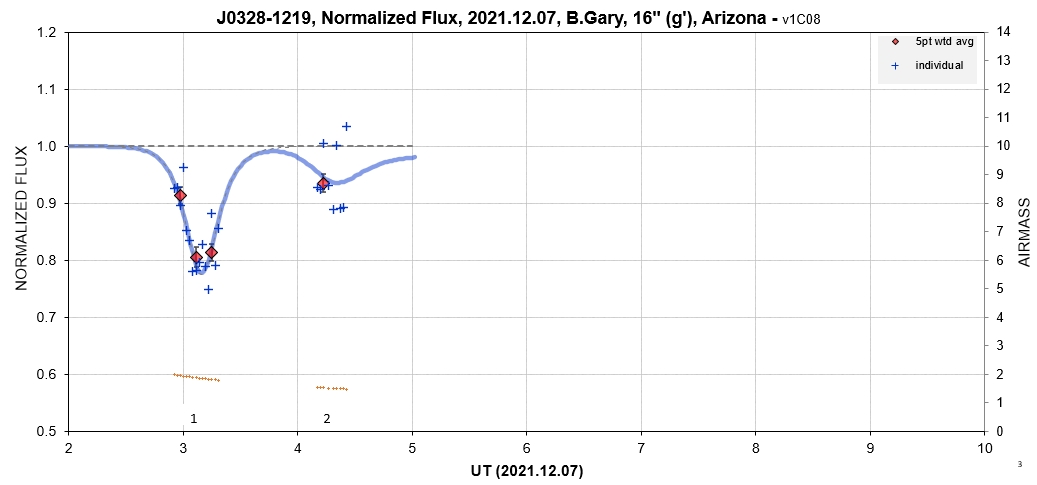
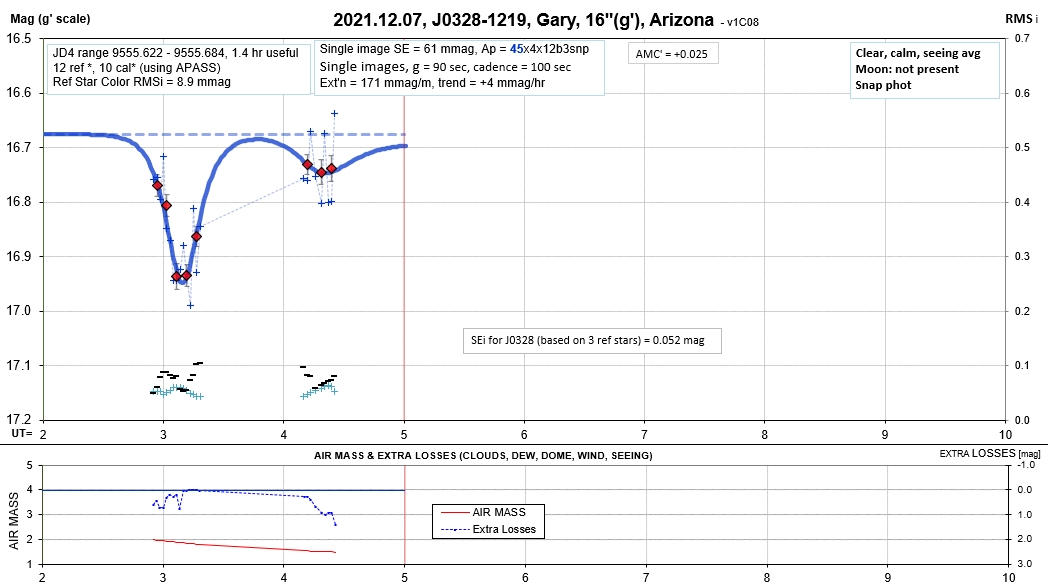
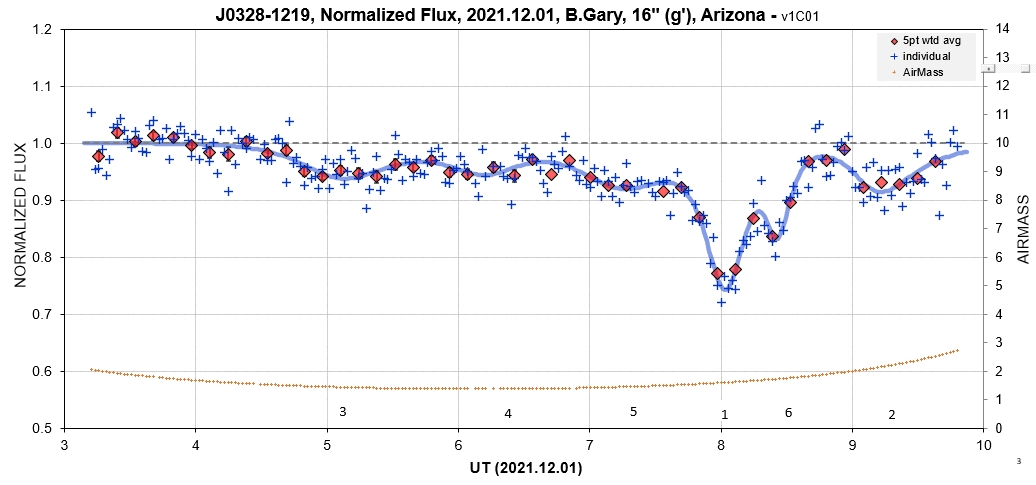
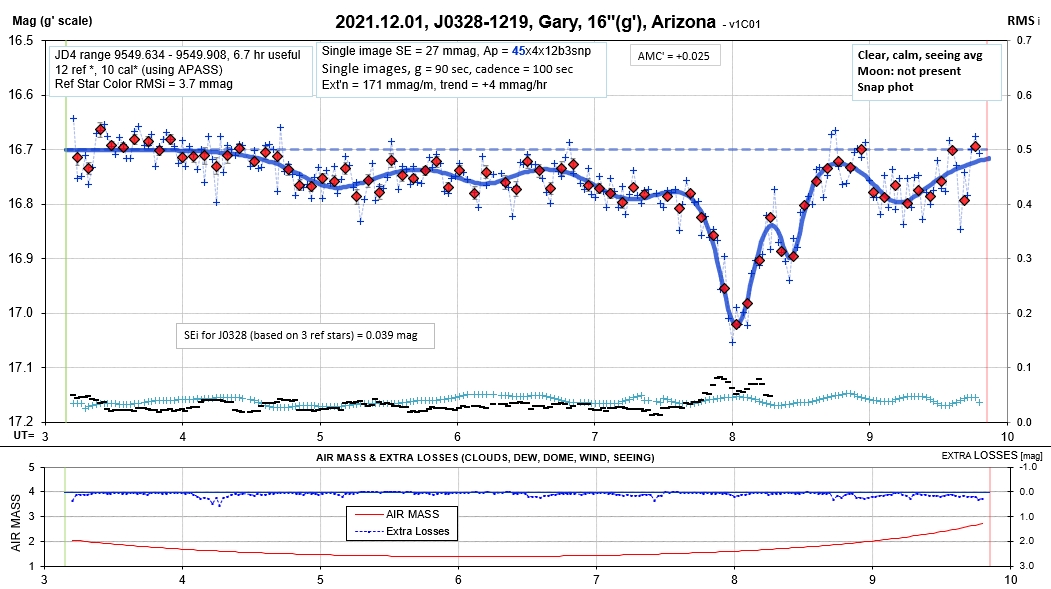
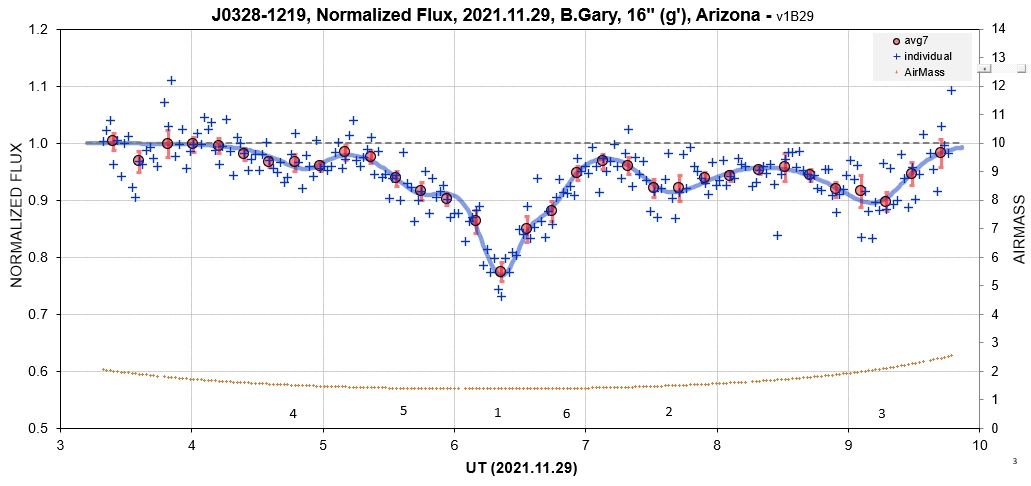
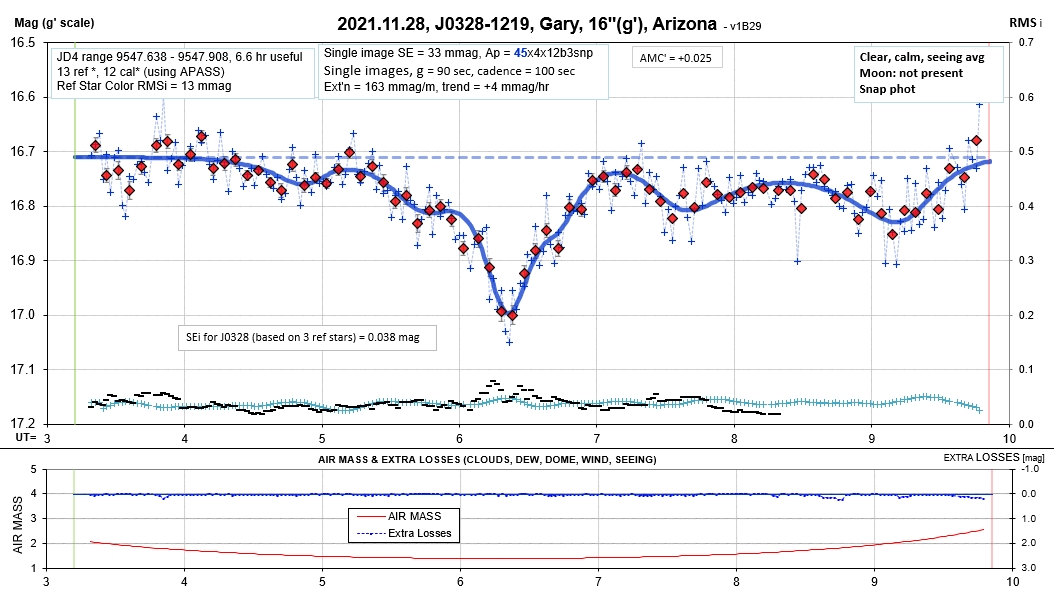
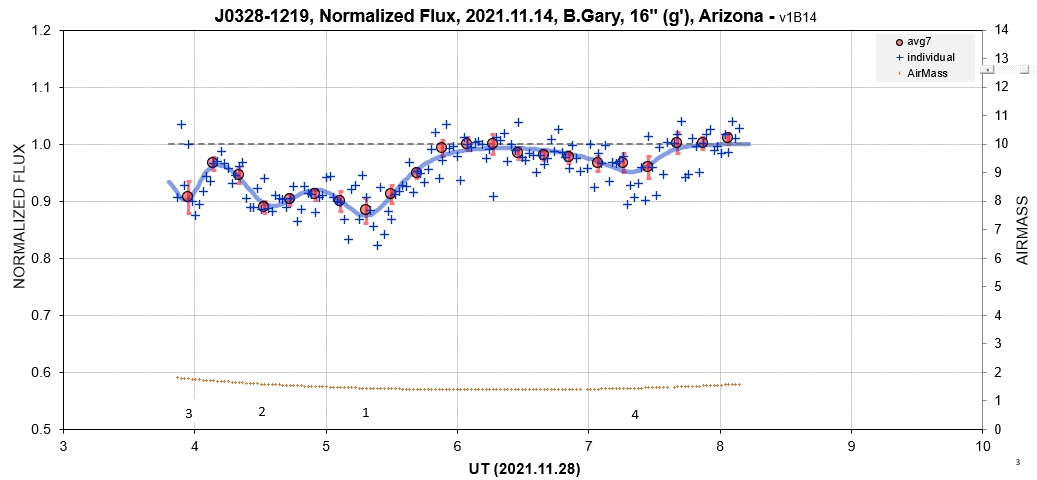
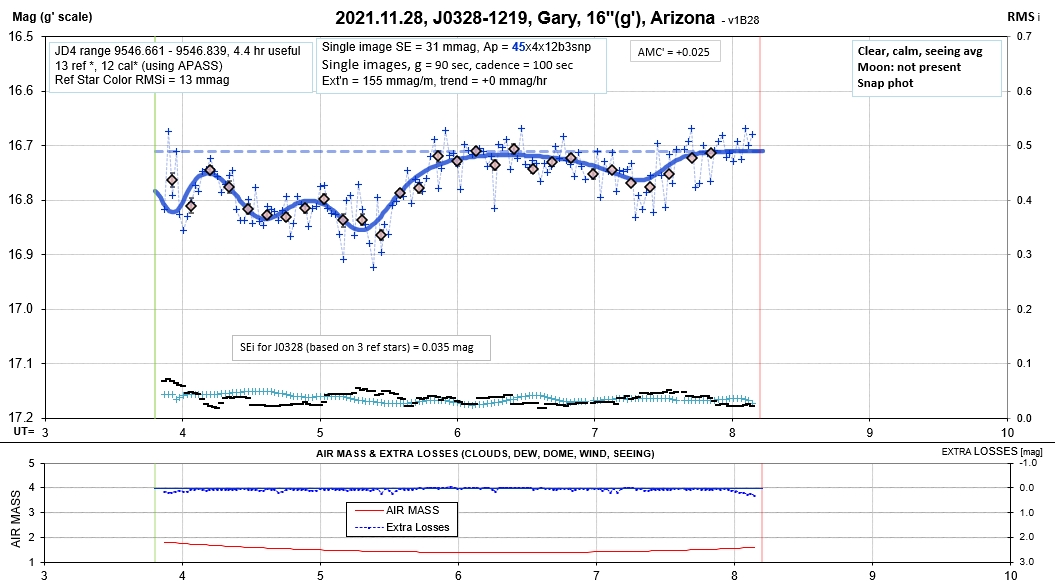
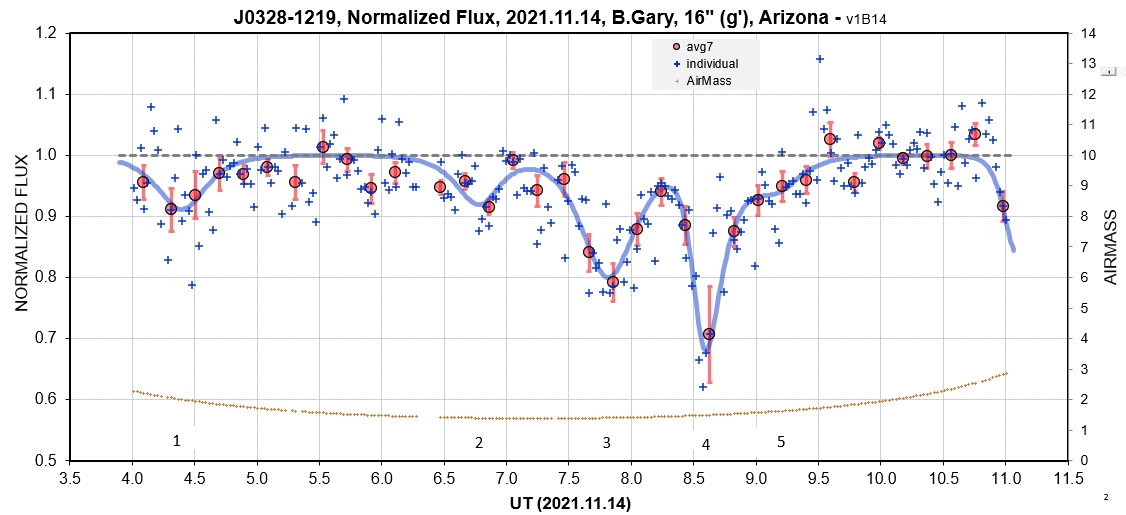
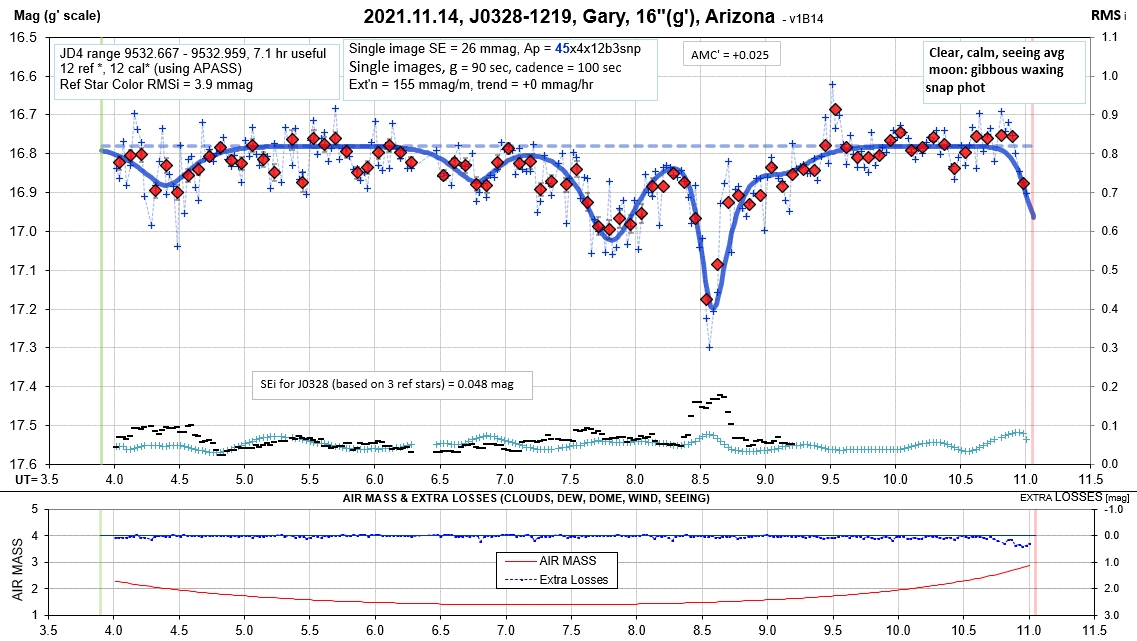
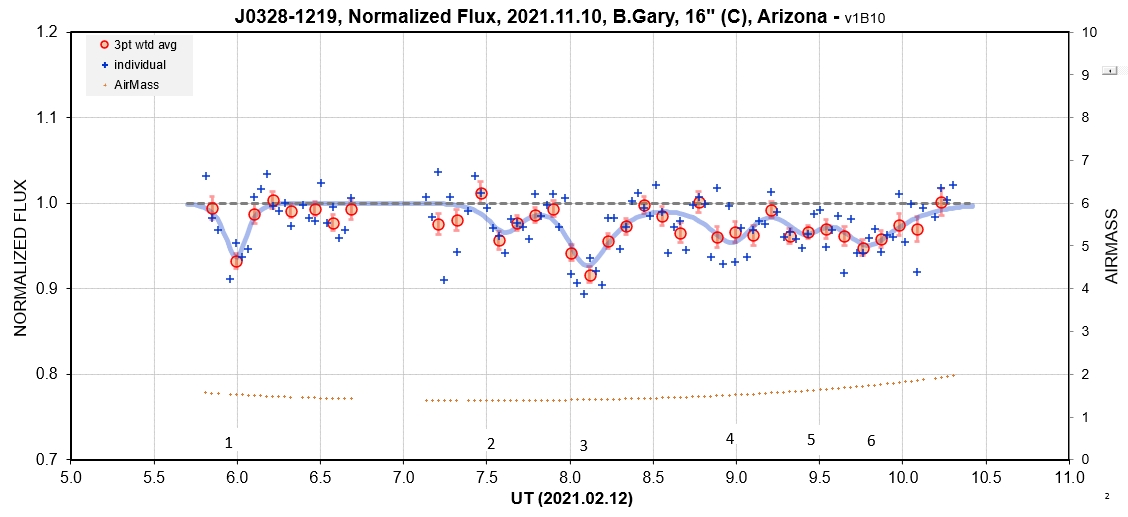
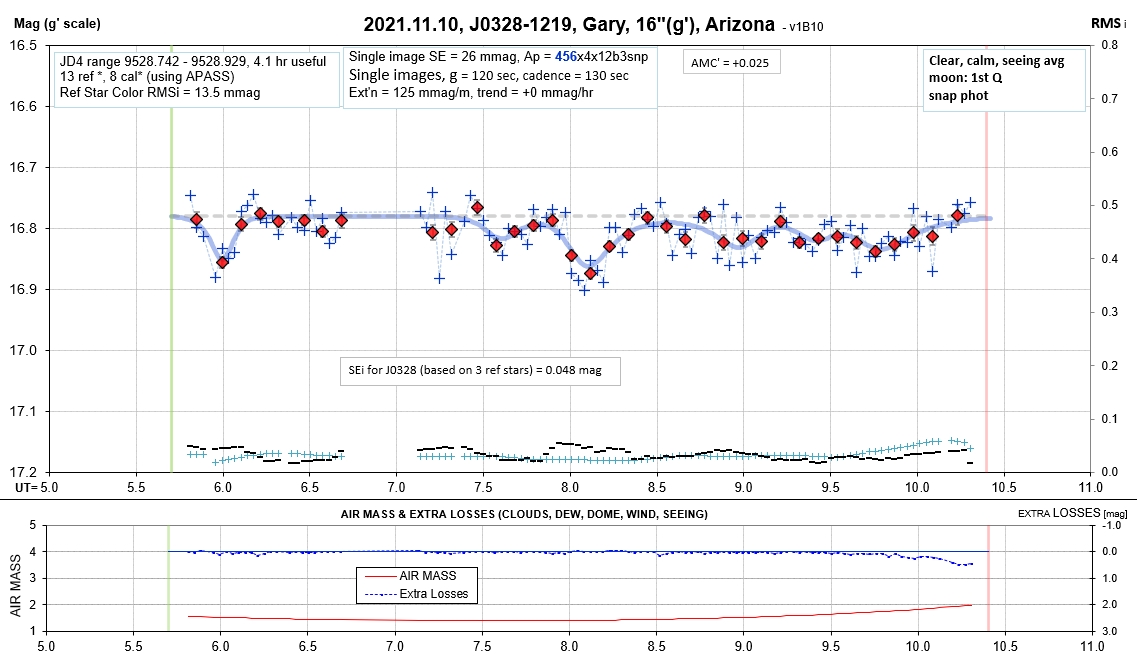
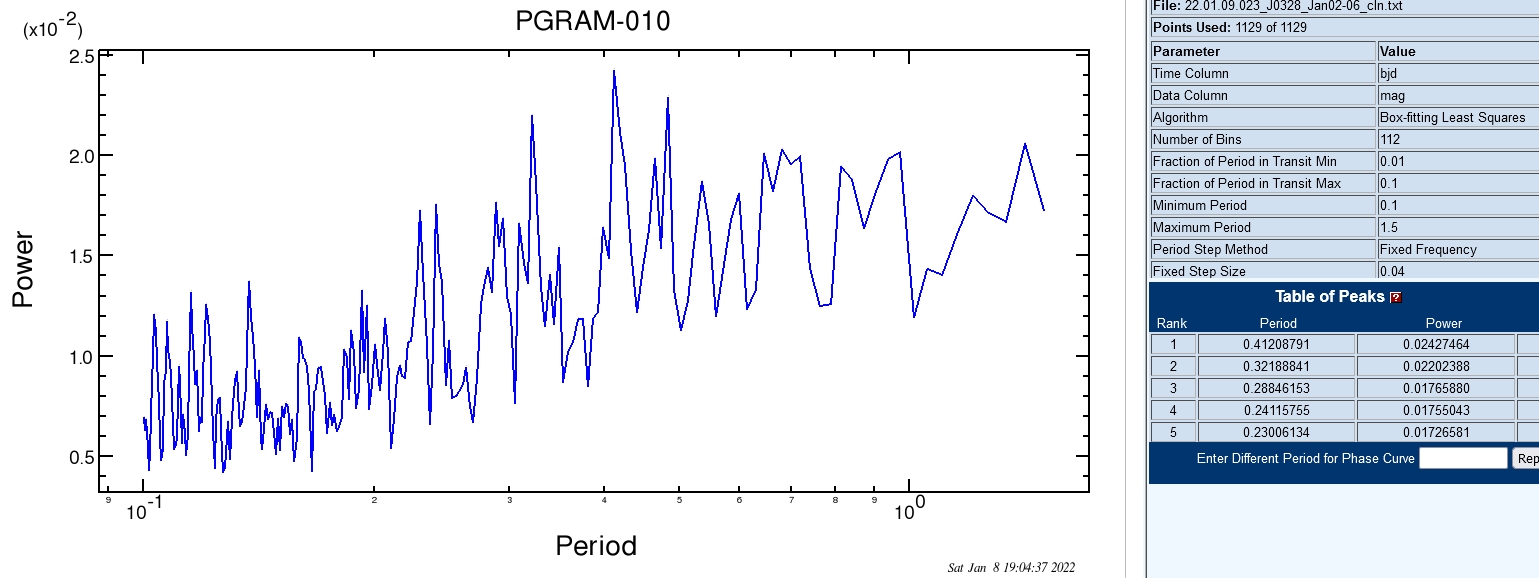
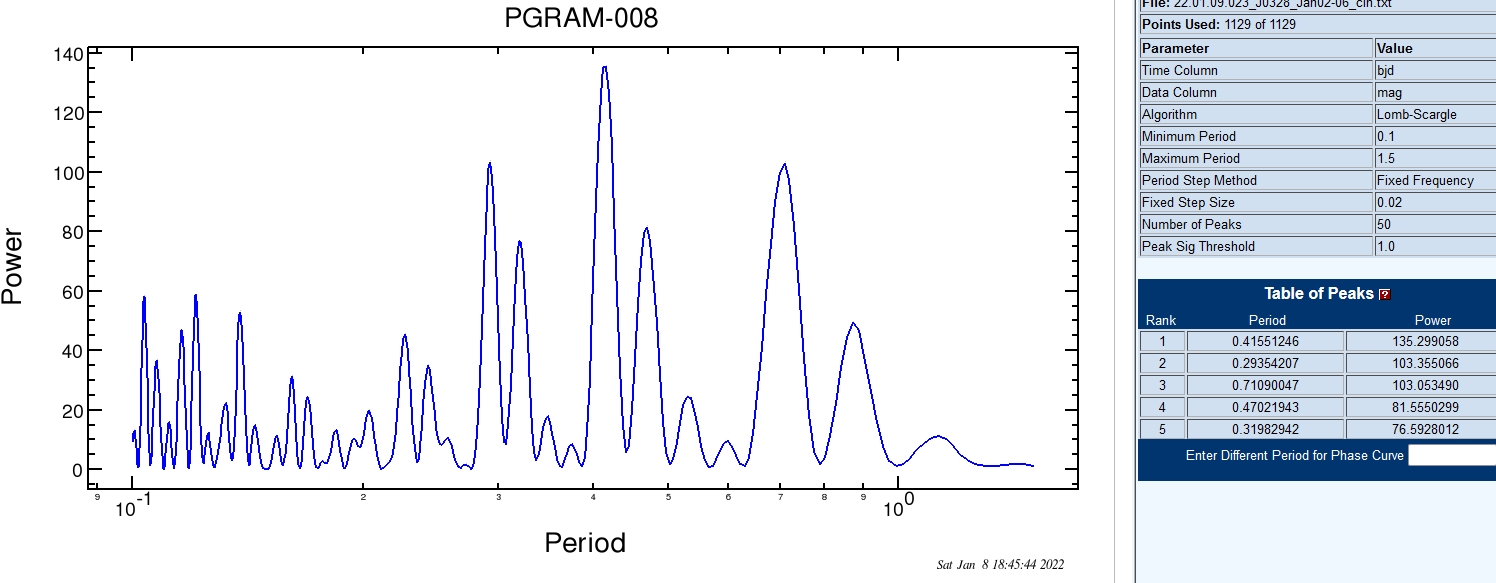
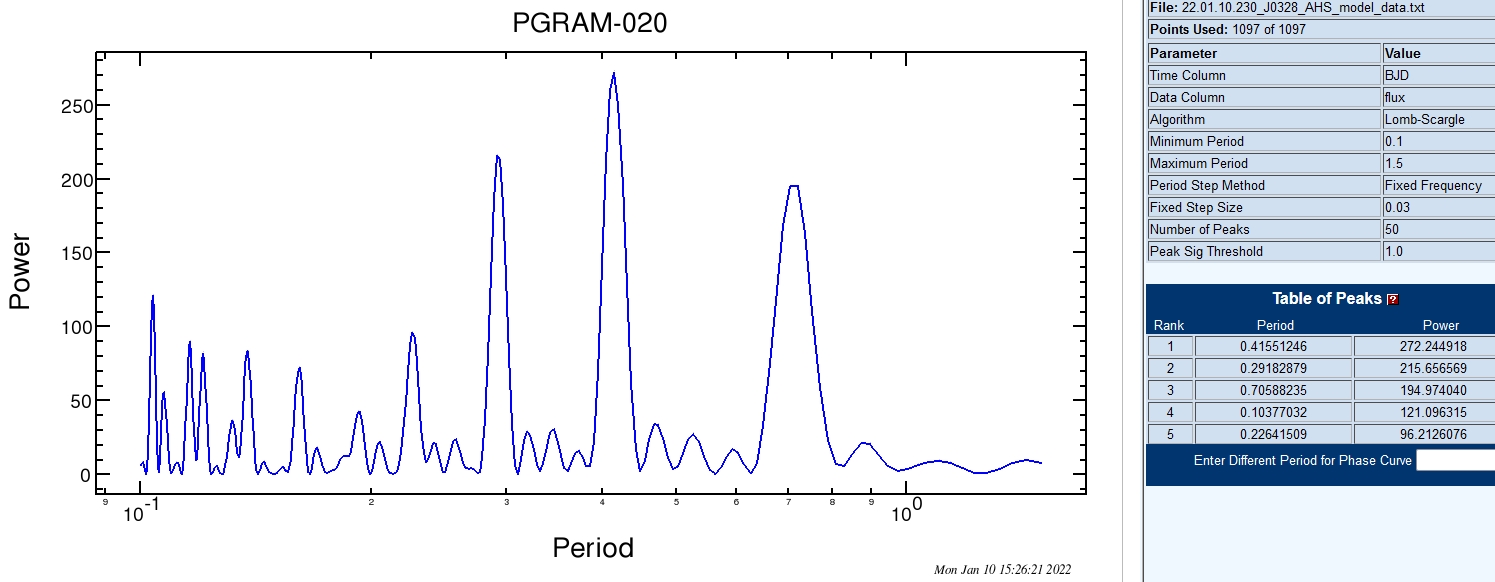
| System |
P [day] |
P[hrs] |
| A |
0.414 day |
9.931 hrs |
| B |
0.47 day |
11.3 hrs |
| C |
0.32 day |
7.68 hrs |
| D |
~ 0.88 day |
~ 21 hrs |
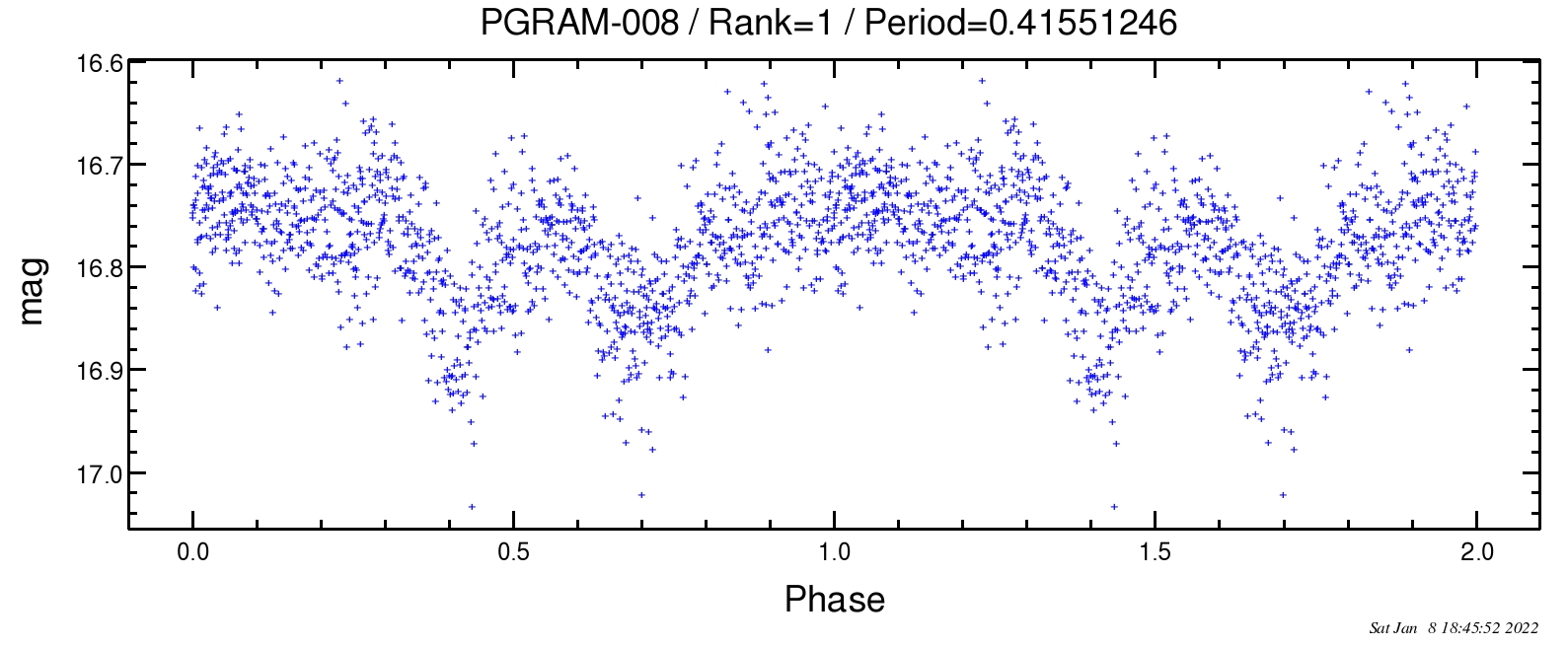
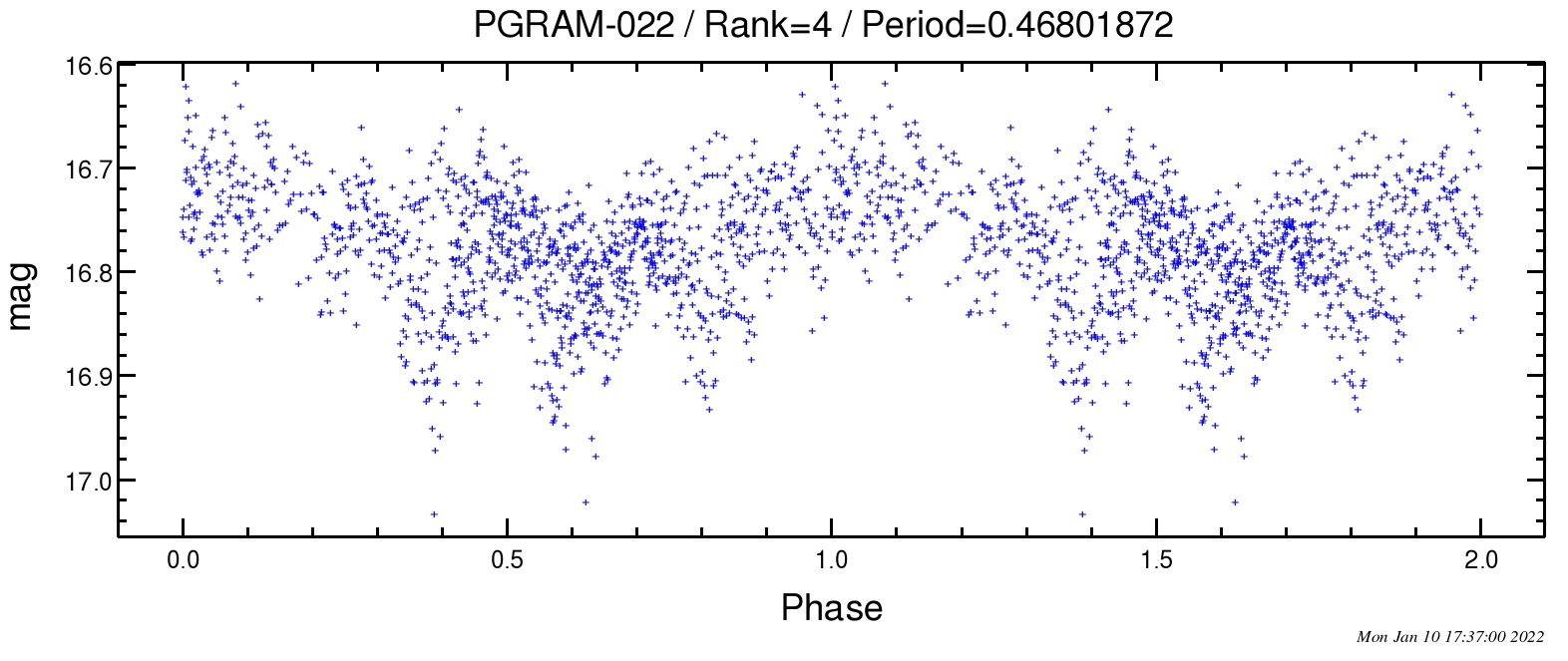
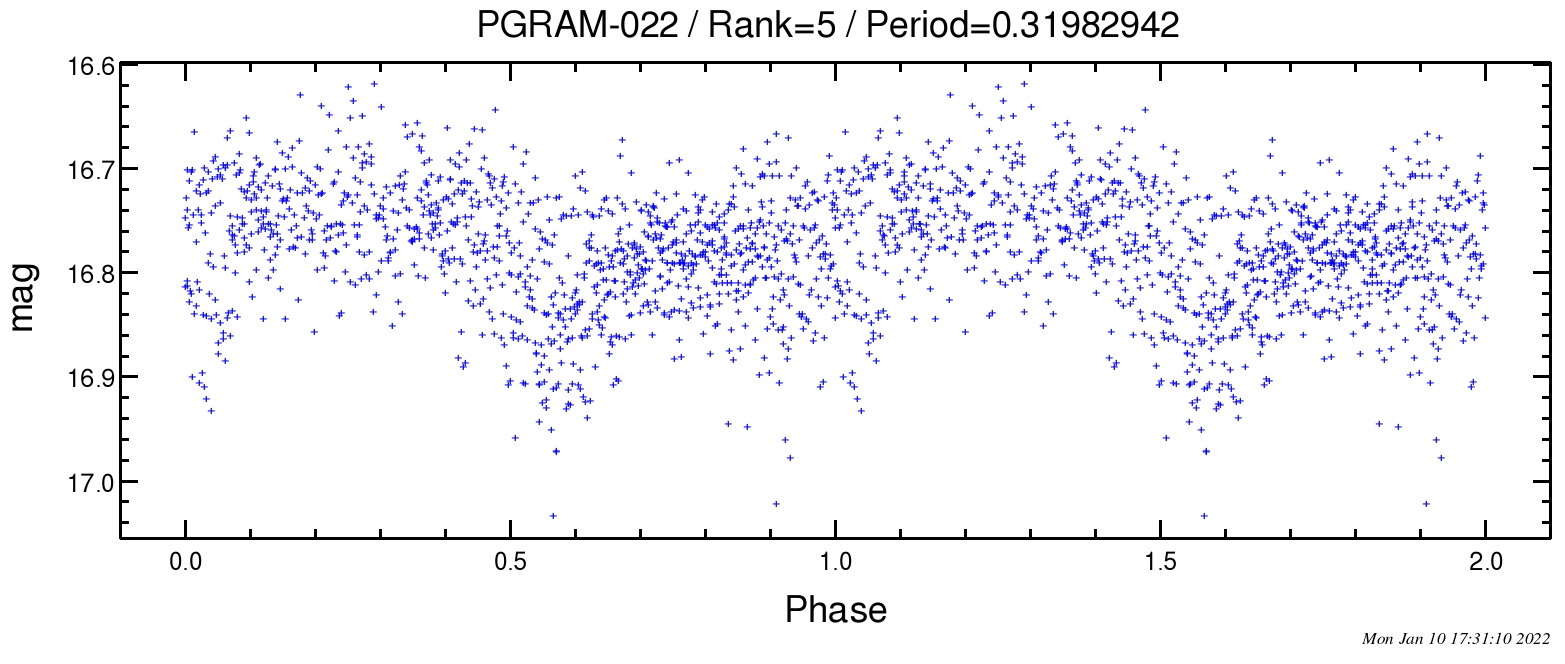
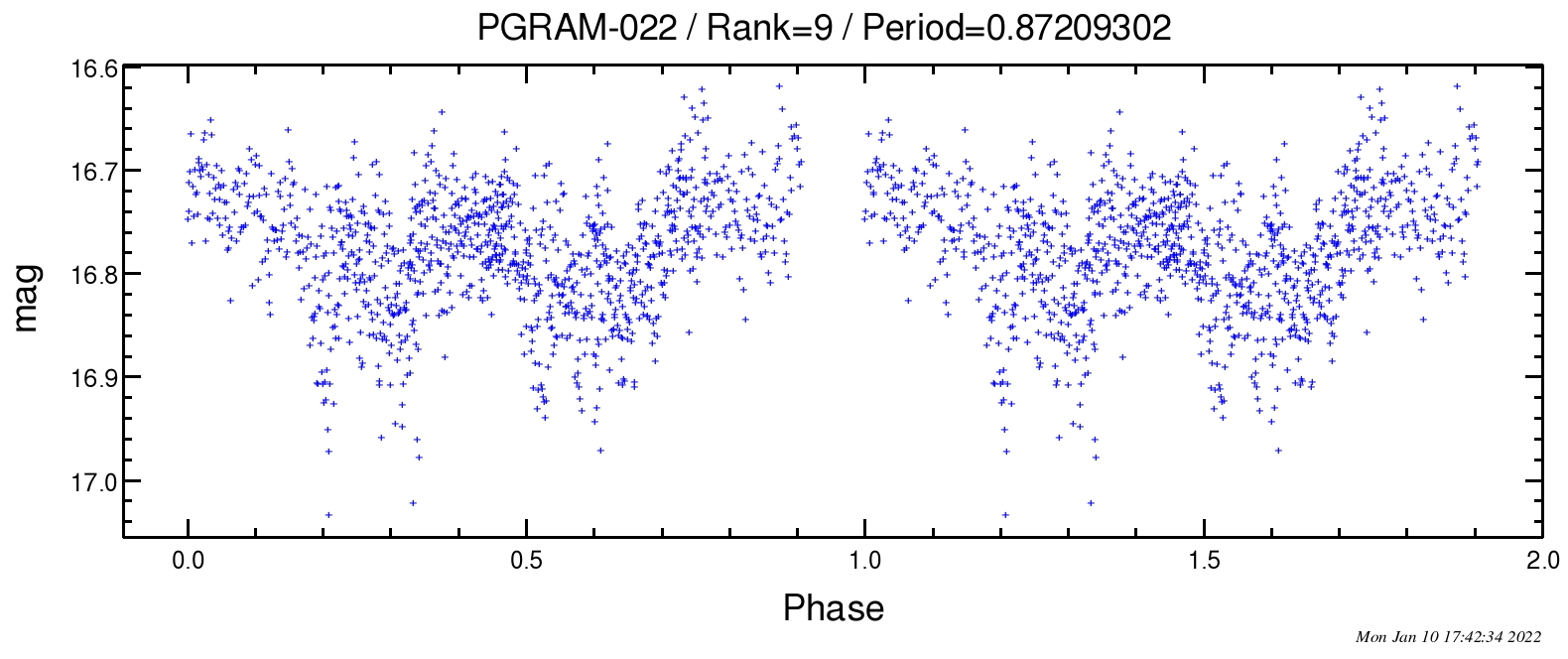
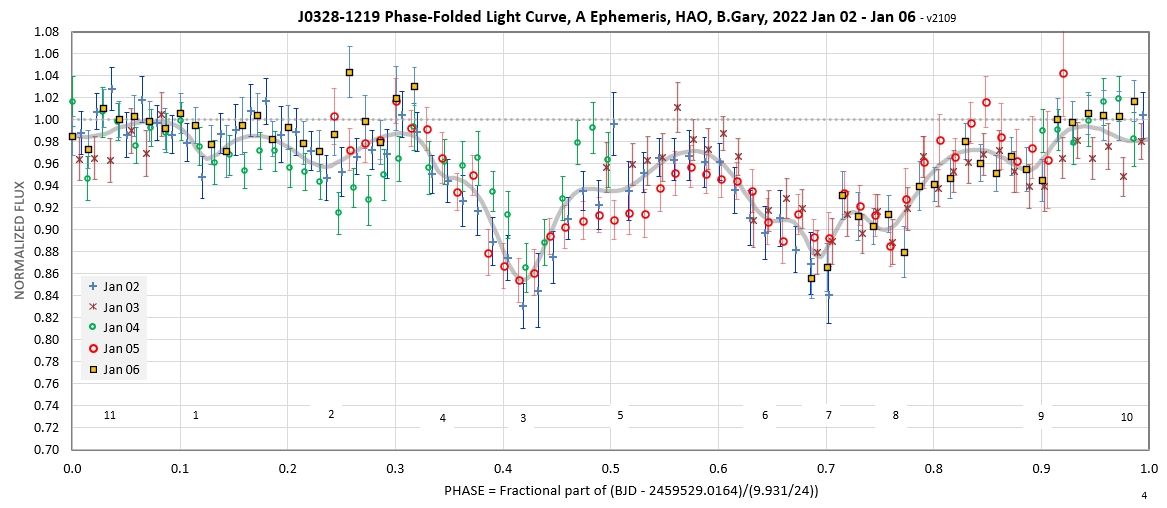
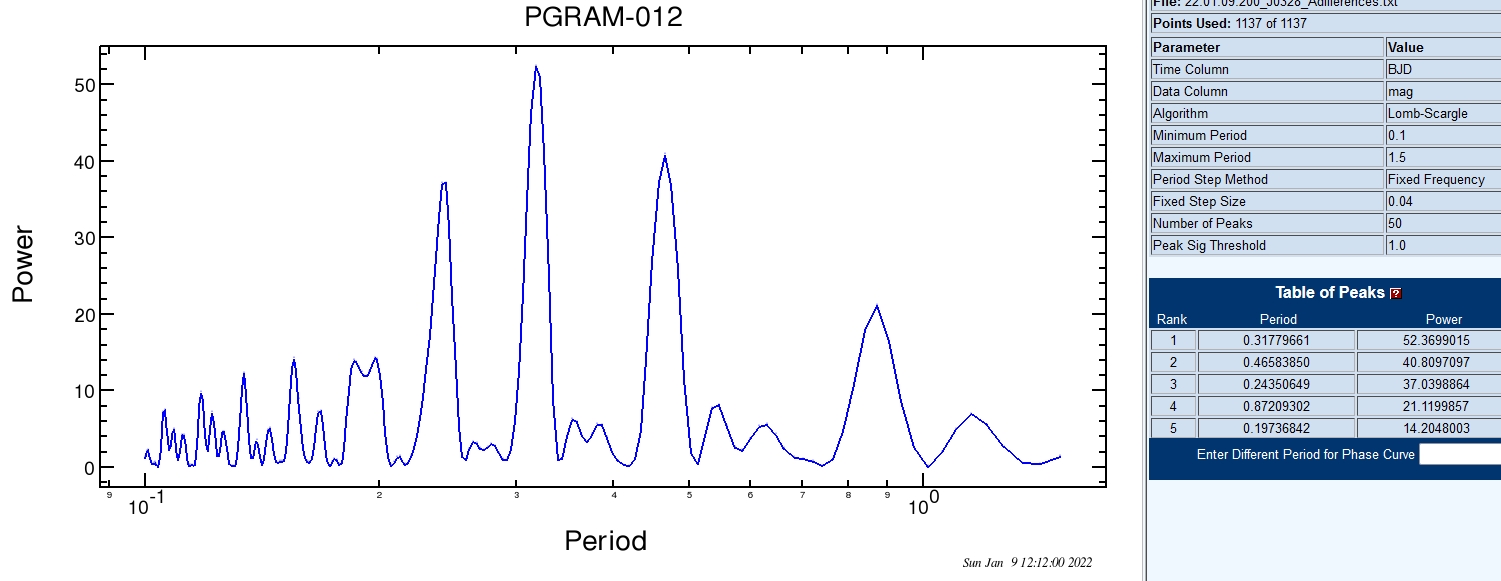
| System |
P[day] |
P[hrs] |
| B |
0.466 day |
11.2 hrs |
| C |
0.318 day |
7.63 hrs |
| D |
0.872 day |
20.9 hrs |
| E |
0.244 day |
5.84 hrs |
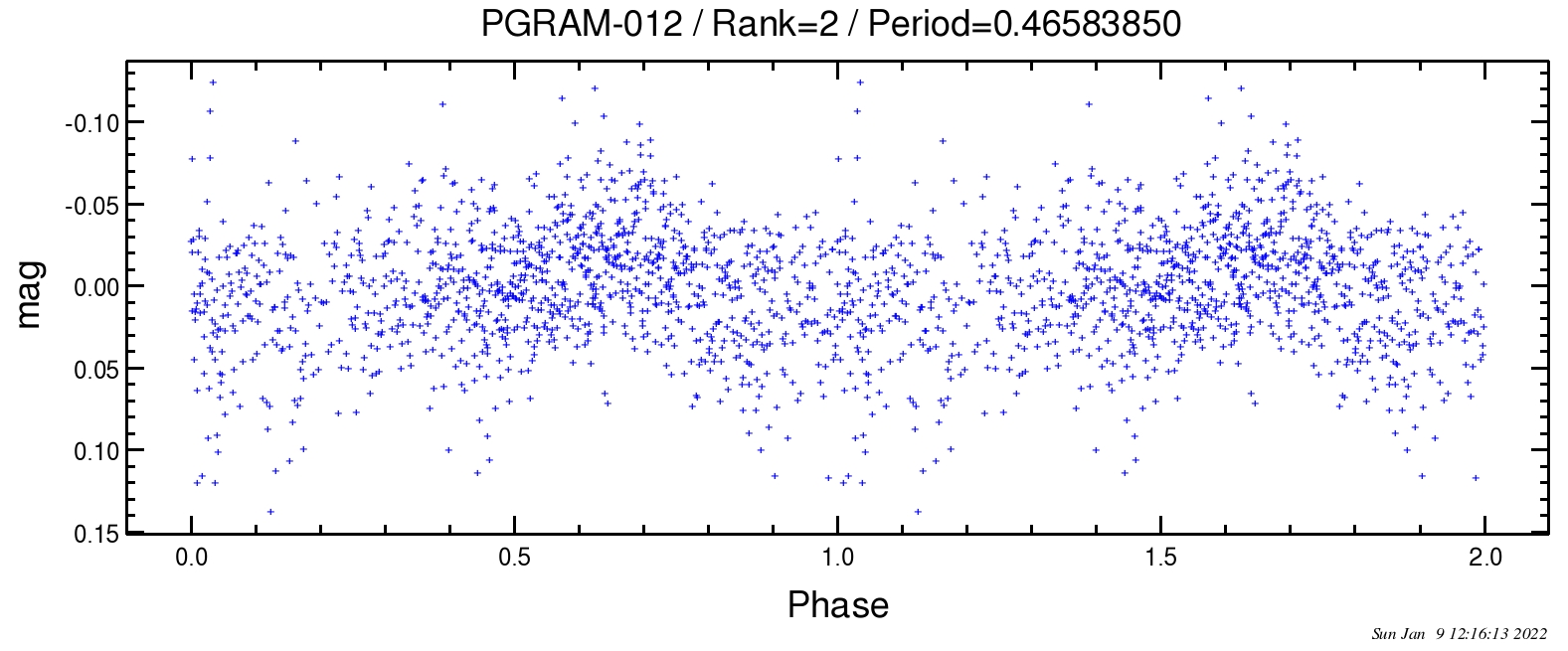
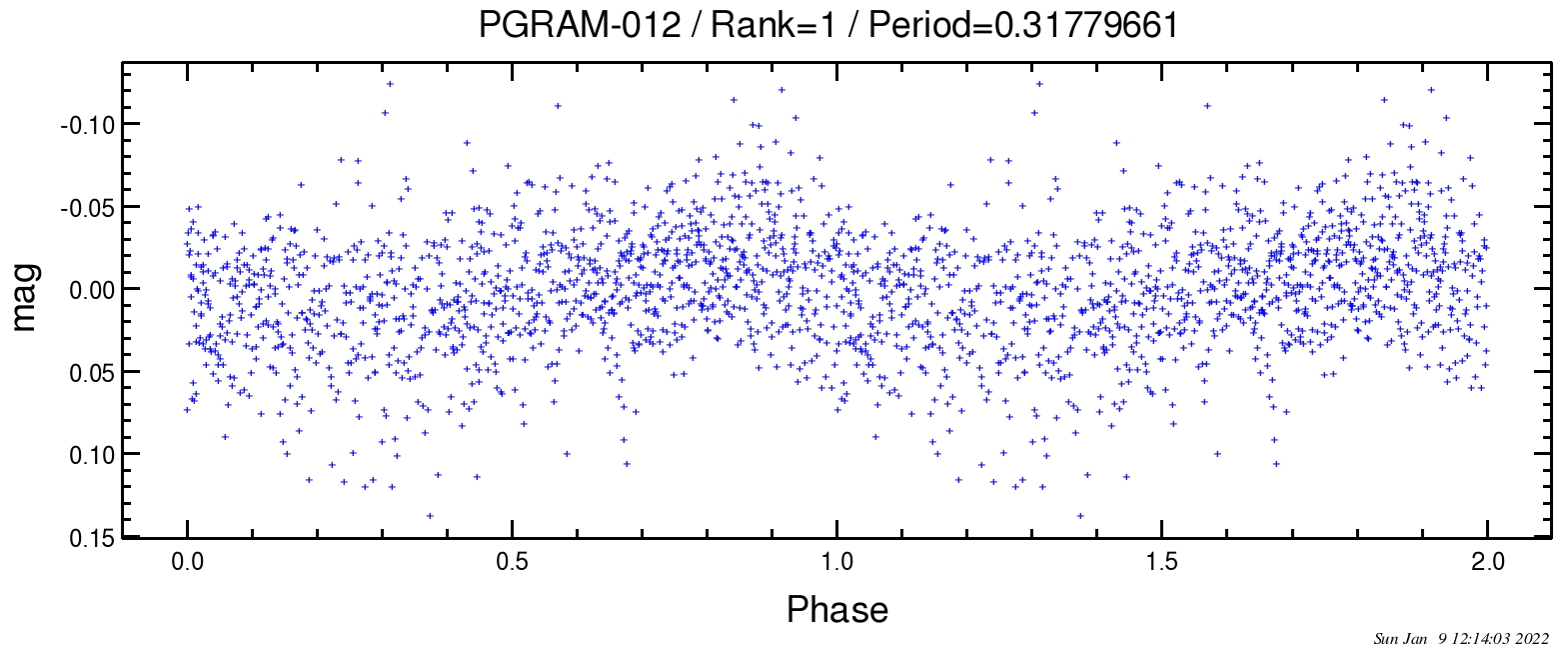
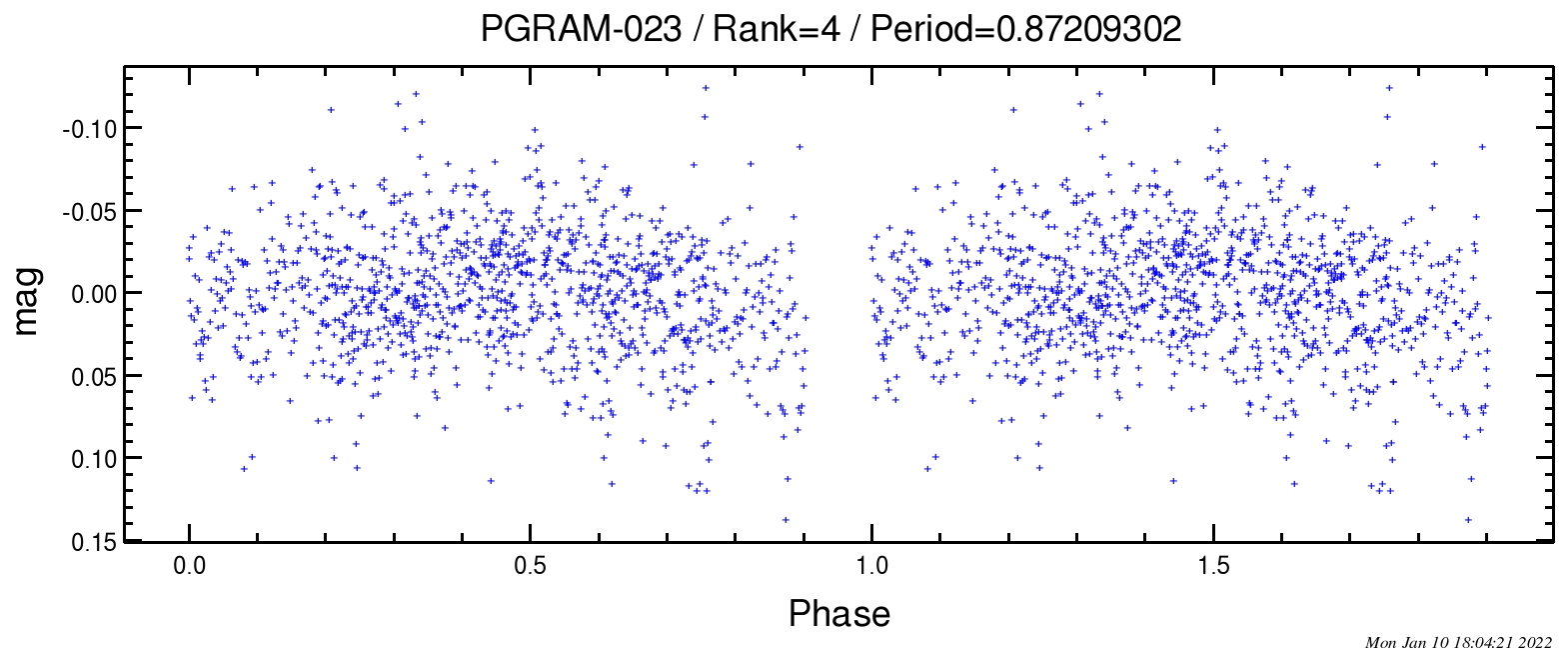
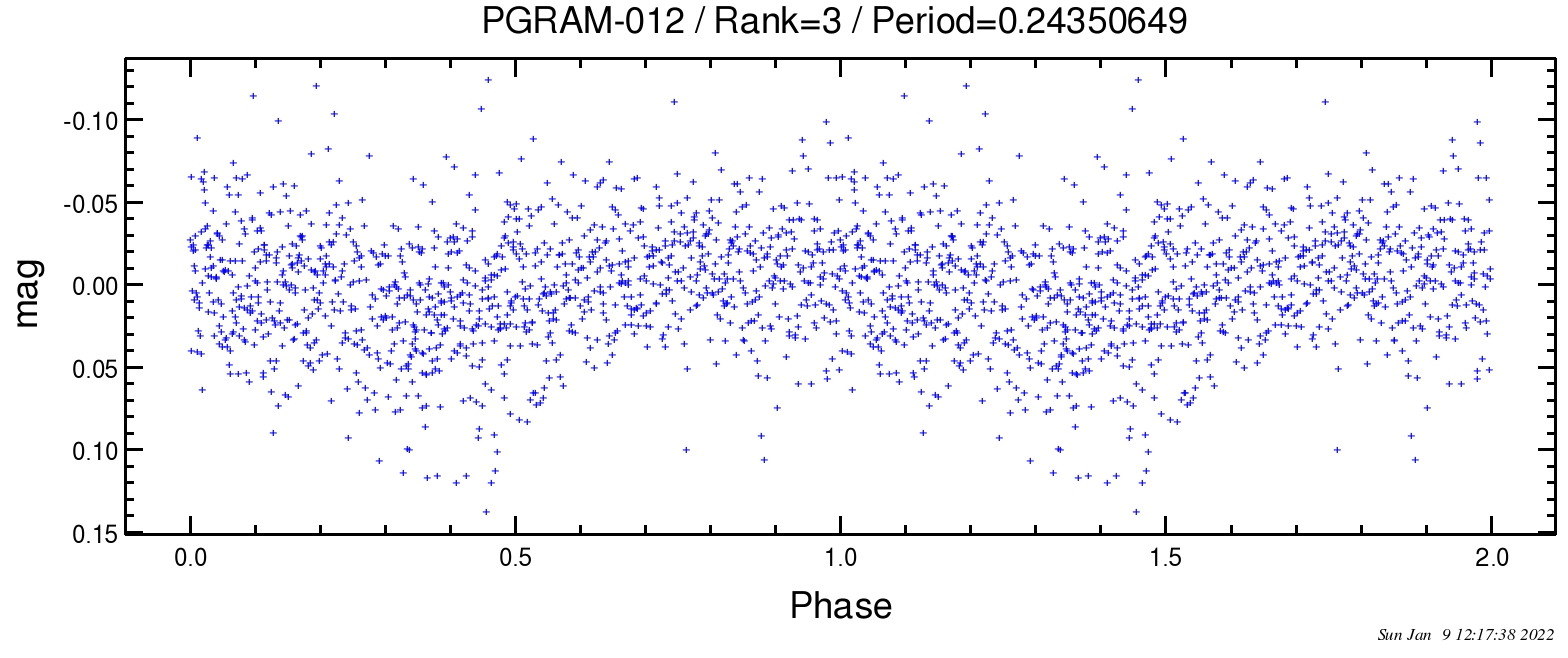

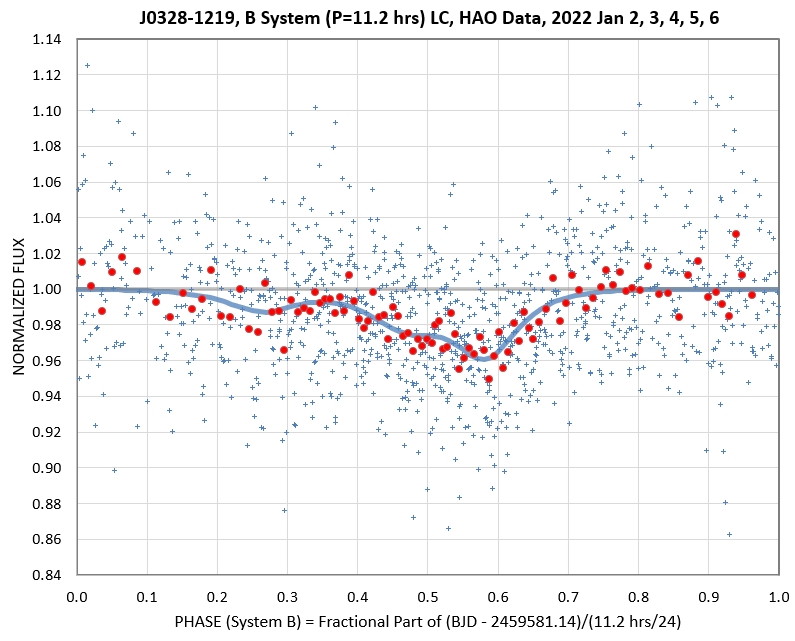
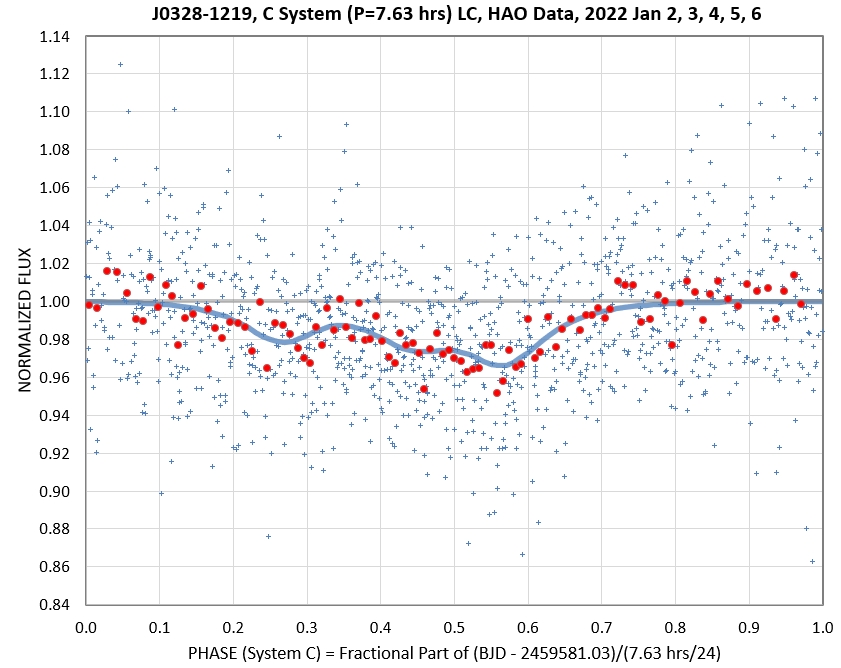
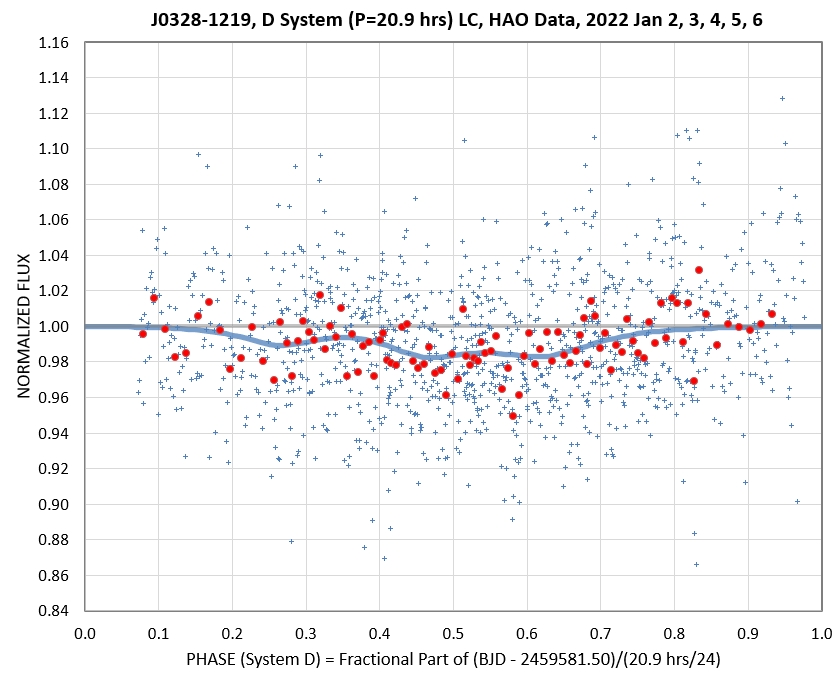
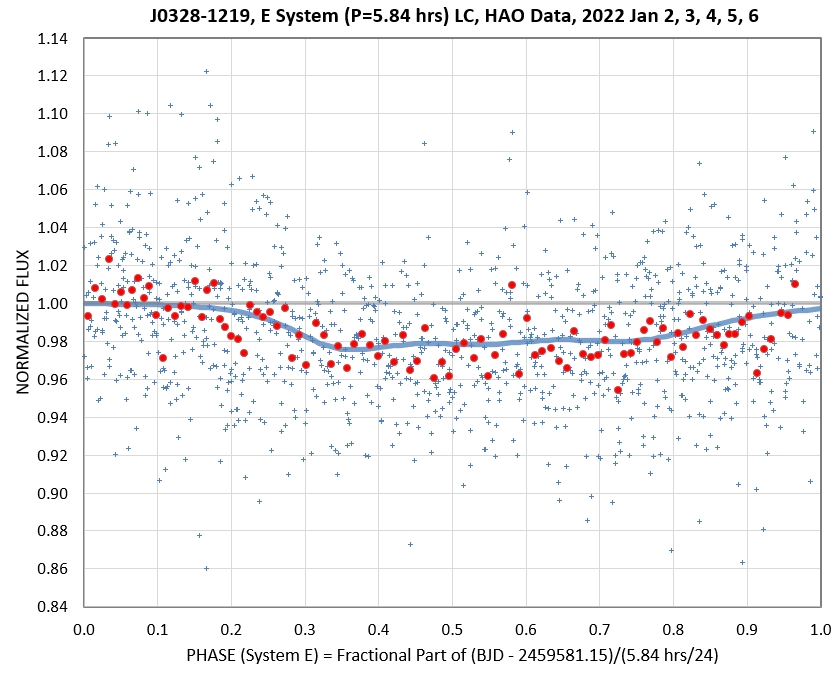
| System |
P[day] |
P[hrs] |
Peak Depth |
Confidence |
| A |
0.414 day |
9.931 hrs | 14.3 % |
100 % |
| B |
0.466 day | 11.2 hrs | 4.0 % |
80 % |
| C |
0.318 day | 7.63 hrs | 3.0 % |
10 % |
| D |
0.872 day | 20.9 hrs | 2.0 % |
5 % |
| E |
0.244 day |
5.84 hrs |
2.0 % |
2 % |
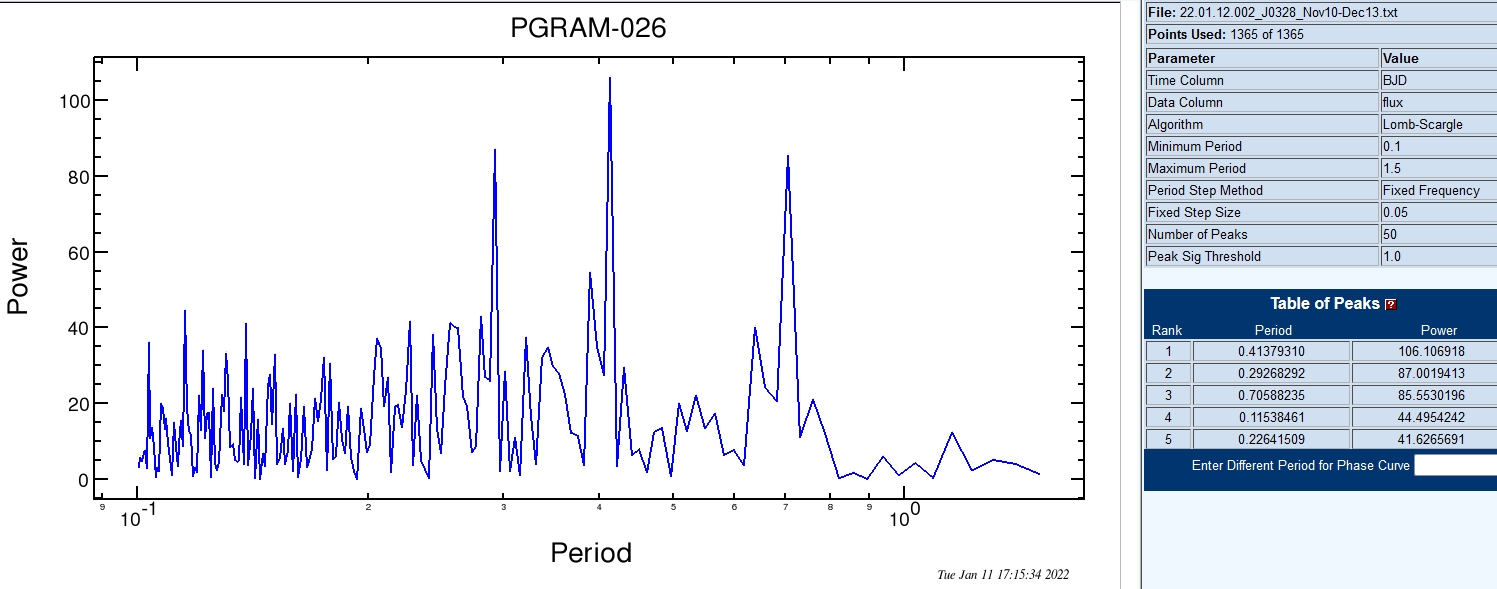

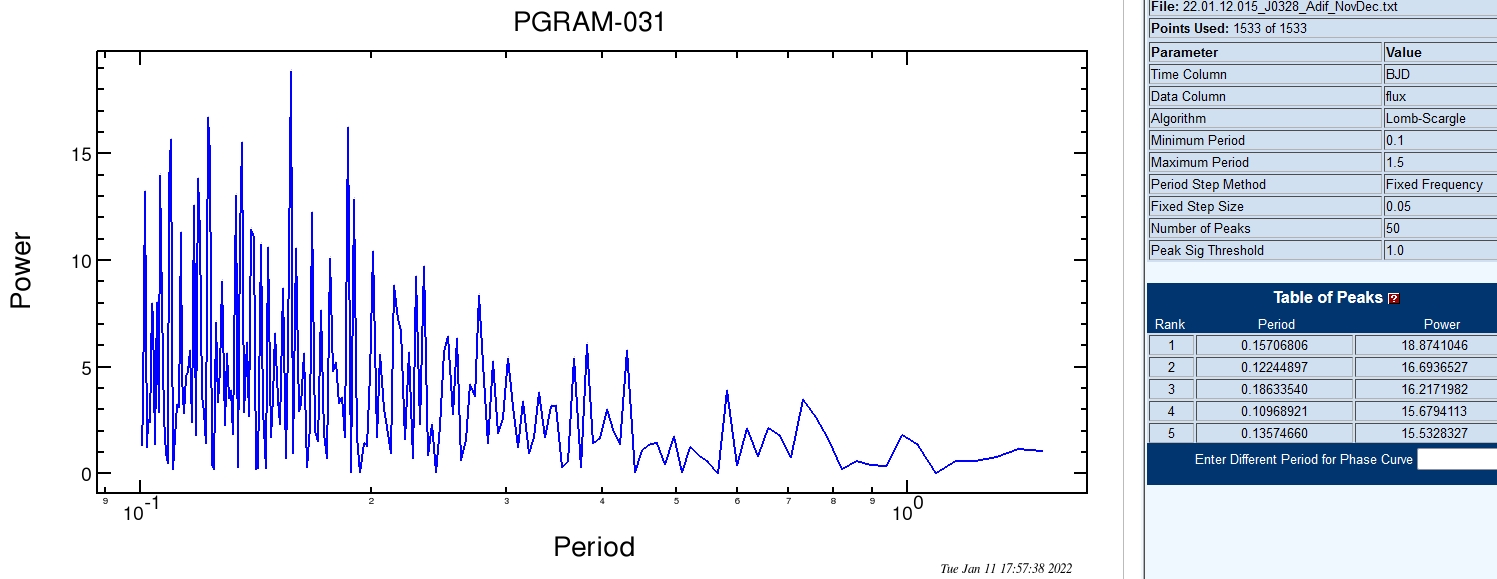
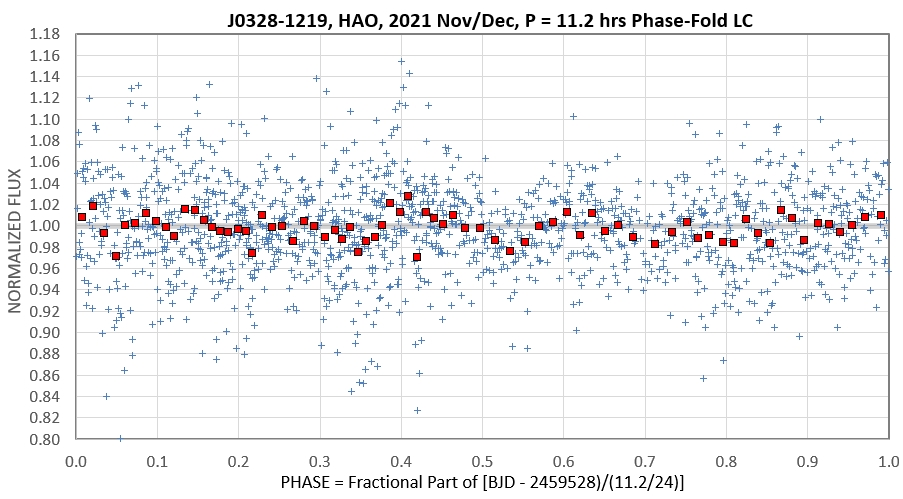
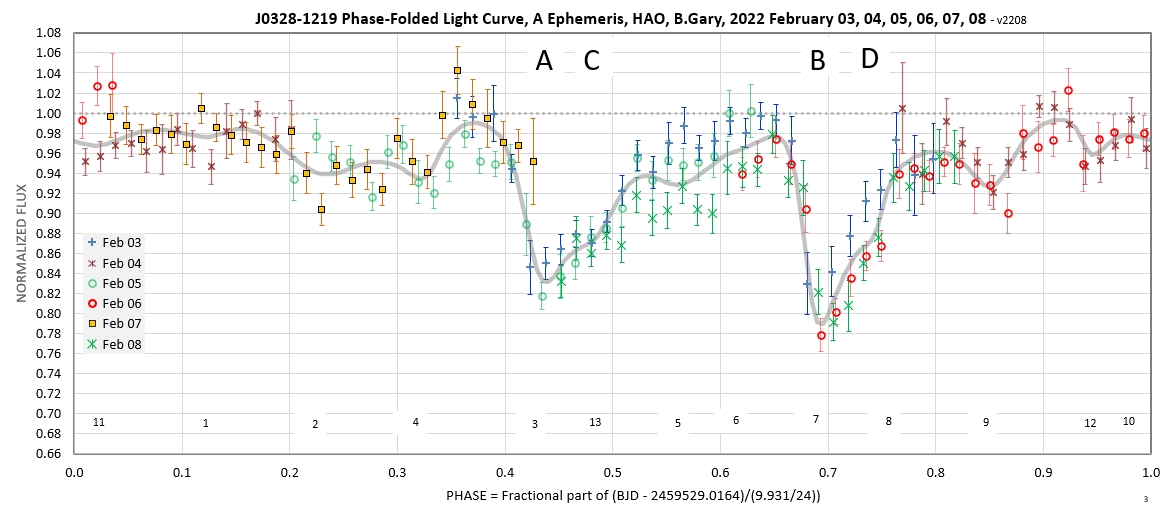



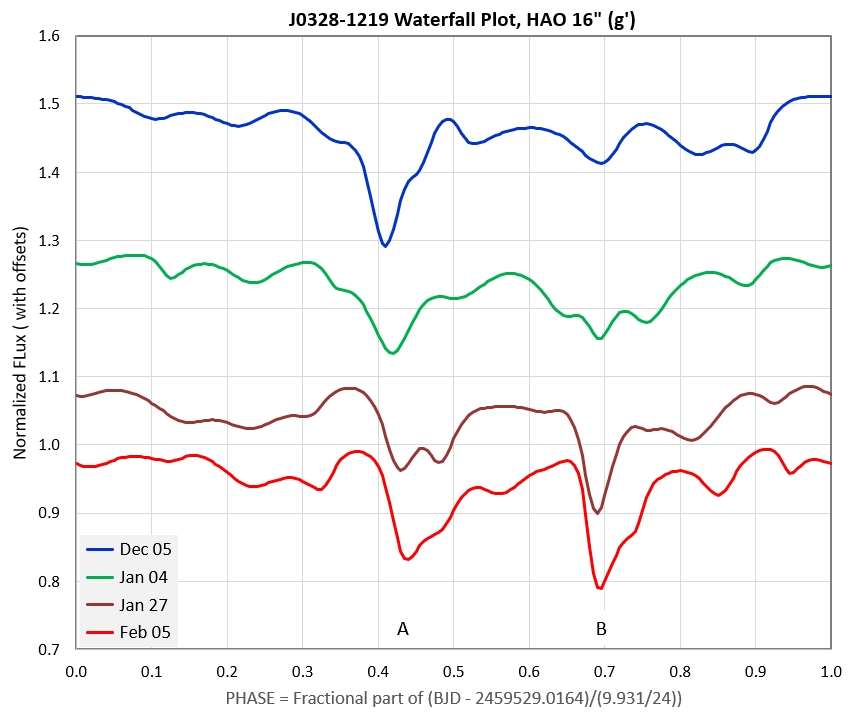
.jpg)
.jpg)
Finder Image
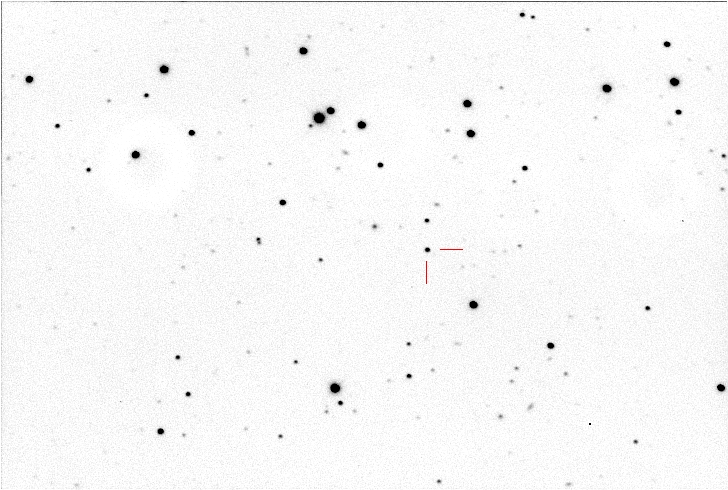
Finder image. FOV = 15 x 10 'arc. North up, east left.
J0328 resembles WD1145 in the following ways: 1) dips are present most of the time, 2) dips exist for weeks to months, 3) the inner-most orbit is the most active in producing dips, and 4) dust clouds are in orbits that can (or must) be close to the WD's tidal radius. J0328 differs from WD1145 in the following respects: 1) J0328 dips are present essentially all the time, whereas for WD1145 there are almost always prenty of OOT time per orbit, 2 ) the J0328 dust clouds are in a larger orbit , with P > twice the WD1145 Ps.
Since the WD1145 dust cloud sources (fragments of a planetesimal
source) are certainly related in some way to being on the verge
of tidal disruption I suggest that the J0628 dust clouds are
produced by the same mechanism. I propose that the fragments for
both WD1145 and J0328 are being bombarded by a background of
rock collisions that become exhausted at the fragment location
after a few weeks to months. This replenishment of dust that is
continually lost from Keplerian shear and radiation pressure
amounts to a steady-state of production and loss, thus
accounting for long timescale preservation of dust cloud shape
(depth and width) that would not occur in the absence of
continual collision bombardment.
When a fragment begins to be bombarded by a swarm
of rocky debris it will start with a shape that is narrow and
will deepen quickly, while eventually reaching a steady-state
level of collisional bombardment. While the rate of rocky
bombardment is constant the dip will have a quasi-constant shape
(depth and width). As the background level of rocky debris
diminishes the dip should broaden and become reduced in depth.
These three life-cycle phases can be thought of as "early,
"middle" and "late." Accordingly, this observing season's A dip
is in a late phase whereas the B dip is in an early phase.
My
Collaboration Policy
Please don't ask me to co-author a paper! At my age of 82
I'm entitled to have fun and avoid work. Observing and
figuring things out is fun; writing papers is work. My
observations are "in the public domain" and are available
for use by anyone. If my data is essential to any
publication just mention this in the Acknowledgement
section.
References
Vanderbosch, Zachary P., Saul Rappaport, Joseph A. Guidry, Bruce
L. Gary and 13 others, "Recurring Planetary Debris Transits and
Circumstellar Gas around White Dwarf ZTF J0328-1219," MNRAS arXiv
Xu, Siyi, Samuel Lai and Erik Dennihy, 2020, "Infrared Excesses
around Bright White Dwarfs from Gaia and unWISE I," arXiv
Guidry,
Joseph A., Zachary
P. Vanderbosch, J.
J. Hermes, Brad
N. Barlow, Isaac
D. Lopez, Thomas
M. Boudreaux, Kyle
A. Corcoran, Bart
H. Dunlap, Keaton
J. Bell, M.
H. Montgomery, Tyler
M. Heintz, D.
E. Winget, Karen
I. Winget, J.
W. Kuehne, 2020, "I Spy Transits and Pulsations:
Empirical Variability in White Dwarfs Using Gaia and the Zwicky
Transient Facility," submitted to ApJ, arXiv
Rappaport, Saul, Roberto Sanchis-Ojeda,
Leslie A. Rogers, Alan Levine & Joshua Winn, 2013, "The
Roche Limit for Close-Orbiting Planets: Minimum Density,
Composition Constraints and Applications to the 4.2-Hour Planet
KOI 1843.03," ApJ L, arXiv
External Links of
Possible Relevance
J0328
Photometry observations by Bruce Gary during observing season
#1 (2020/2021)
WD1145 summary of 4
observing seasons
WD1145 for 2020/21
observing season
Resume of
webmaster
This site opened December12, 2021. Nothing on this
web page is copyrighted.